V
Can you name them aLL? .
Where do we stand? pg. 13














Where do we stand? pg. 13














Can you name them all? Nine figures are depicted on the cover created by Art Director Jeslyn Chen — five local or national political figures and three Palo Alto High School students. This cover was inspired by a cover from an October 2004 issue of Verde. Answers are on page 9.
Verde Magazine, a news and features magazine published by the students in Palo Alto High School’s Magazine Journalism class, is a designated open forum for student expression and discussion of issues of concern to its readership. Verde is distributed to its readers and the student body at no cost.
The staff welcomes letters to the editors but reserves the right to edit all submissions for length, grammar, potential libel, invasion of privacy and obscenity. Send all letters to verdemagazine1@gmail. com or 50 Embarcadero Rd Palo Alto, CA 94301.
Advertising
The staff publishes advertisements with signed contracts providing they are not deemed by the staff inappropriate for the magazine’s audience. For more information about advertising with Verde, please contact our business manager at verdebusiness5@ gmail.com.
Printing & distribution
Verde is printed five times a year in September, November, February, April and May by Folger Graphics in Hayward, California. The Paly Parent Teacher Student Association mails Verde to every student’s home. All Verde work is available at verdemagazine.com.
Editors-in-Chief
Felicia Buchholz
Austin Eng
Asha Kulkarni
Nadia Soberg
Anna Van Riesen
Features Editor
Lizzy Williams
Profiles Editors
Lia Cardwell
Otto Kiss Meyerfreund
Culture Editors
Divya Gandhi
Cate Graney
Perspectives Editor Vit Do
News Editor
Alma Bendavid
Launch Editor
Ella Hwang
Copy Editors
Lia Cardwell
Lizzy Williams
Business Manager
Maya Rajbhandari
Social Media Managers
Chloe Huang
Sophie Mies
Art Director
Jeslyn Chen
Staff Writers
Niaz Alasti
Nathalia Arias
Eva Chang
Zachary Crystal
Stefan Eriksson
Keshav Kapur Srinivasan
Andrew Kassel
Lilia Kuzmicheva
Jaron Leung
Kensie Pao
Lara Saslow
Augustus Soedarmono
Ethan Zhang
Adviser
Paul Kandell





By the time this issue is published, Super Tuesday will be two weeks away. On that day, 15 U.S. states (including California) host their primaries. Along with the presidential race, 2024 is a momentous year for California elections. For the first time in decades, both a seat to represent California in the U.S. Senate and the 16th U.S. congressional district are open.
We felt it was important to highlight these political events at a time when, according to U.S. News & World Report, 49% of young Americans believe the nation is on the wrong track. When crafting stories for this issue, we wondered what our classmates believed about politics.
The Verde staff of 2004 had the same question. Twenty years ago, they set out to answer it, surveying almost 300 members of the Palo Alto High School student body. This cycle, we recreated a modified version of that survey, handing out paper ballots to four social studies classes per grade. We counted 390 student responses by hand and are excited to present and analyze the results in “Where do we stand?”
We thank and appreciate the Verde staff members who facilitated these surveys, the students who thoughtfully filled out the survey, the teachers who gave up class time for this project and the help of Social Studies Instructional Lead Mary Sano to coordinate this effort. And of course, we appreciate the thorough example set by the 2004 staff of Verde.
The survey wasn’t the only idea we “borrowed” from 20 years ago — we also put a retro spin on their magazine cover to highlight recognizable national figures, local politicians and Paly students who engage with the political process. (It’s okay if you can’t name them all. By the end of this issue, we hope you can!)
Several other stories from our magazine also highlight political issues. For instance, in “Eleven voices, one seat” staff writer Niaz Alasti and Profiles Editor Lia Cardwell profile candidates in the 16th district congressional race.
In addition to races for national office, a local election holds relevance for Paly. Former Paly journalist Bilal Mahmood is campaigning to unseat Dean Preston, the current San Francisco District 5 Supervisor. In “Alum for election,” Launch Editor Ella Hwang and staff writer Augustus Soedarmono reveal Mahmood’s goals for the city and the lessons he learned from his time on The Paly Voice.
As student journalists, one of the lessons we’ve learned is that young people can and should voice their opinions about the nation’s political future. In an editorial, we do just that, weighing the potential repercussions of a presidential race between a 77-year-old and an 81-year-old and examining why electing older politicians poses problems for the younger generations.
We recognize that most of the student body is not yet eligible to vote. But we hope that this issue will make readers, whether you’re a Paly student or have voted for longer than we’ve been alive, a little more informed on the political processes that will shape your lives for years to come. Here’s to March 5!
THE FUTURE IS SUING THE past. Eighteen children from California are taking the U.S. to court over climate inaction that they claim violates their constitutional rights.
The plaintiffs, aged 8 to 17, argue in Genesis B. v. U.S. Environmental Protection Agency, that climate change disproportionately impacts children and future generations, thus infringing upon their rights to life, liberty, property and equal protection under the law.
Allegedly, the EPA has been allowing pollution from companies that burn fossil fuels to continue despite knowing the risk it poses to American citizens.
By holding the EPA responsible, the children aim to force them to hold polluters accountable.
We applaud and stand in solidarity with all plaintiffs in the lawsuits who took a stand against climate change. Additionally, we encourage students to take initiative and learn more about climate change to improve the health of our environment.
Effects of climate change not only include temperature and air conditioning price increases, but also arguably recent storms California experienced, which caused power outages in many Palo Alto homes.
According to the LA Times, climate change causes heat waves to that feature heightened temperatures and storms that feature increases in intensity.
As stated by the National Oceanic and Atmospheric Administration, the average temperature worldwide has increased by more than one degree Fahrenheit, causing

sea levels to rise.
Meanwhile, according to the Federal Reserve Economic Data, heating, ventilation and air conditioning prices have doubled since 2004 in the U.S.
The California lawsuit follows in the steps of other lawsuits that aim to use the courts to make the government tackle climate change.
One such lawsuit was the 2020 case Held v. State of Montana. The plaintiffs, aged 5 to 22, forced the Montana government to consider climate change when deciding whether to approve or renew fossil fuel projects.
Instead of receiving financial compensation for the pollution caused by fossil fuel projects, the plaintiffs received a promise from the state to reconsider its environmental policies and practices to take into account the potential climate impacts.
Genesis Butler, a 17-year-old high school student from Long Beach, participated in the California lawsuit last December.
Coming from a family that can’t afford air conditioning, she aimed to raise awareness and advocate for action regarding climate change.
“I saw the Montana lawsuit … and I saw how successful that was,” Butler told Verde. “So I wanted to join one.”
Deborah Sivas, an environmental law professor at Stanford University who has been involved as a mentor in cases like Held v. Montana State, said she believes that climate lawsuits are a good way to raise awareness.
“It’s hard to predict whether they [climate lawsuits] would be successful at the end of the day, but I think they are a vehicle for really raising consciousness around this [climate change],” Sivas said.
Butler said she believes that the best way to combat climate change is to spread awareness that individual people can still make a difference.
“Just know that this [climate change], is a real issue,” Butler said. “Do whatever you can to speak up about it.” v

in U.S. presidential elections was a topic of interest in the 2020 presidential election and is a pressing issue as the 2024 U.S. presidential election commences.
Presumed Republican nominee Donald Trump is 77 years old, and current president Joe Biden holds the record for the oldest president in U.S. history at 81 years old.
According to the Pew Research Center, the median age of members of the U.S. Congress is 57.8 years old, and the median age of Senators sits at 65.4 years old. When comparing these numbers to the median age of US citizens (38.9), the scope of the underrepresentation of younger populations within the government is evident.
This underrepresentation can be attributed, in part, to the low proportion of Millennial and Generation Z voters compared to the proportion of Generation X and Baby Boomer voters.
The Brookings Institution highlights that younger voters, particularly those under 45, are increasingly influential in elections and have different priorities from older generations.
However, according to NPR, only 27% of people under age 30 voted in the
2022 midterms in comparison to 60% of Generation X and 67% of Baby Boomer voters.
As highlighted by the Center for Information & Research on Civic Learning and Engagement, among young people who didn’t vote, more than one in five said they did not have enough information. In addition, a separate article by CIRCLE reports that youth are passionate about issues and often want to engage in the political process, but they frequently face barriers to participation.
The lack of information on politics among youth is confirmed by a Verde survey conducted on 390 Palo Alto High School students across all 4 grades, where 69% of Paly respondents said that if they could vote, they would be unsure about which candidate they would choose to represent the 16th congressional district and 78% reported being uncertain when it came to voting for the Senate seat.
the lack of education on politics and current news provided to students; however, given constraints such as budget and curriculum limitations, blame for this issue cannot be placed solely on educators.
We instead encourage every student to take the initiative in learning about the political landscape of our nation and to vote when they are eligible, even if they do not support every single view a candidate holds.
By engaging in the political process, young people can help tackle critical issues
Steps students can take to better their understanding of the political landscape and political candidates include staying informed through reliable news sources like Ballotpedia and Cal Matters, attending local committee meetings, and registering to vote.
In addition, 16% reported they would choose not to vote at all in the November presidential election.
Many are quick to criticize schools for
By engaging in the political process, young people can help tackle critical issues such as climate change, where the effects may not be fully realized in Biden or Trump’s lifetime but will impact our generation.
If we desire change for issues that will affect our future, we must push for representation in the government. v
with ASB President Julian Hong
Q: Are there any upcoming Spring events that are being planned?
A: “We have Spring Spirit Week coming up ... some thing that we started last year and really wanted to start building up this year. We’re planning on so far, hav ing two large rallies and also integrating it with Quad chella more closely, so we can have a sense of spirit thst lasts all year, not only during Spirit Week, and I hope that all Paly students are just as invested as Iam and will dress up for all the days.
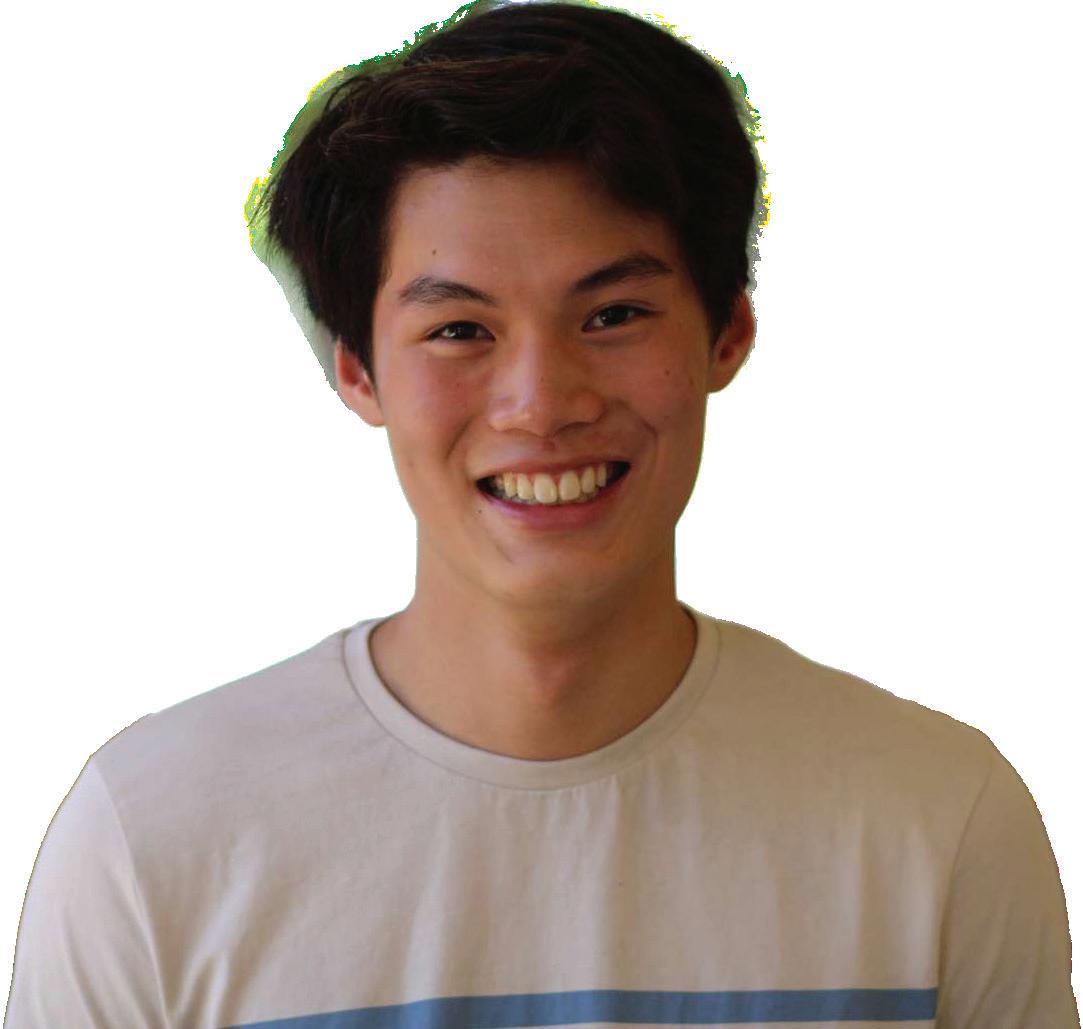

TOP MIDDLE: Kamala Harris, Vice President
TOP RIGHT: Bella Nguyen, Senior Class President
MIDDLE LEFT: Donald Trump, former president
CENTER: Karthi Gottipati, School Board Representative
MIDDLE RIGHT: Julie Lythcott-Haims, Palo Alto City Councilwoman and congressional candidate
BOTTOM LEFT: Joe Biden, current president
BOTTOM MIDDLE: Anna Eshoo, former CA-16 Congresswoman
BOTTOM RIGHT: Julian Hong, ASB President
TOP MIDDLE: Arnold Schwarzenegger, California governor
TOP RIGHT: Hillary Clinton, Senator
MIDDLE LEFT: John Kerry, presidential candidate
CENTER: Palo Alto High School student, name unknown
MIDDLE RIGHT: George W. Bush, president
BOTTOM LEFT: Paly student, name unknown
BOTTOM MIDDLE: Condoleezza Rice, National Security Adviser
BOTTOM RIGHT: Paly student, name unknown

ON DISPLAY (top left)— Palo Alto High School’s Visual and Performing Arts students showcase their art around school during a week of “Art in Unusual Places.” This collection of drawings and paintings were displayed outside of the art building.
DELIGHTED DOLL (top right) — A doll happily sits in a tree outside of the 200’s building in the week of Feb. 5.
STARRY SKIES (bottom right) — A colored paper artwork is shown with intricate cutouts depicting a house under the night sky.


Photos by Kensie Pao
At the beginning of each class, chemistry teacher Aparna Sankararaman shows a slideshow of some of the favorite jokes that
I once wrote a book on how not to fall down stairs.
It is a step-by-step guide.
Q: What music do mummies lis ten to on Halloween?
A: Wrap music!
I told my son to go find out what “nada” means. But he came back with nothing.
she has heard. Here are a few of them:
People who take care of chickens are literally chicken tenders.

Justice is a dish best served cold. If it were served warm, it would be justwater.
Q: What does a nosy pepper do?
A: Gets jalapeño business

ASAFETY UPGRADE AT THE Alma-Churchill intersection, a primary access point for many Palo Alto High School students, is expected to continue until the upcoming fall school term.
The City of Palo Alto, who started on the project five months ago, is planning to install a pre-signal, add street light upgrades, widen the sidewalk and update signage and striping. Currently, crews are surveying the intersection to identify and
resolve any conflicts with the sewer system below.
According to Ruchika Aggarwal, project engineer for the city, the objective of this project is to improve safety and traffic flow.
“It was identified that some immediate improvements needed to be done at this intersection for the safety of pedestrians and bikers and vehicles,” Aggarwal said. “It’s a joint project aimed at improving the safety of bikers, pedestrians, and cars traveling along that corridor.”
A student who navigates the intersection daily, however, says that he does not see safety as a concern at the intersection.
“Just like any other crosswalk, sometimes depending on if a train comes I’ll have to wait longer, I think it’s pretty safe,” said Parker Castro, a sophomore. “I wait at the light and go when the crosswalk turns green so I don’t really see any issues with it.”
by STEFAN ERIKSSON
PROTESTING FOR CEASEFIRE — A protestor screams “ceasefire” during the congressional debate on Jan. 31 at the Palo Alto City Hall. She along with a group of Stanford graduate students went to the debate to protest for a ceasefire in the Middle East, ultimately cutting the debate short. Adam Dawes, CEO of Embarcadero Media, which sponsored the event, told Verde that “things broke down when the audience wanted to make demonstrations, and we had difficulty keeping order so that the candidates could speak their piece,” Dawes said. Photo: Kensie Pao

thousands of Palo Alto residents without electricity, multiple homes damaged and some flooded streets.
Approximately 3,380 Palo Alto residents experienced power outages, according to a Palo Alto utility department report. In addition, some students have witnessed tree branches falling in their neighborhood.
Palo Alto High School sophomore Satoshi Isayama recalled the exact moment a tree branch fell outside his window.
“While I was studying, I heard a loud thud outside my house,” Isayama said.
“I went outside and saw that a huge tree branch had fallen.”
In the storm’s wake, custodians placed caution tape around the eucalyptus tree just off Paly’s Quad. According to Assistant Principal Jerry Berkson, the tape, which has since been removed, was set in place to protect students from branches potentially falling.
“It was a safety hazard,” Berkson said. “Safety is our No. 1 priority here at Palo Alto High School.”
by ETHAN ZHANGDistrict’s new Middle College High School will allow for 120 Palo Alto High School students to attend the program as of fall of 2024.
Located on the Foothill College campus, there will now be spots for 60 sophomores and 60 juniors, according to Emily Garrison, the Middle College Principal. This is significantly more than the previous 35-student limit between all grade levels in the similar program they had in previous years.
Paly sophomore Lucas Irulegui applied for the previous program last school year, and said he is interested this year. “There’s
more classes, there’s more things to do.” Irulegui said. “I didn’t get in because there’s a lot of people trying to do it.”
He said that he is happy to have a better chance of getting in next year, thanks to the increased student capacity.
PAUSD’s new program will provide opportunities for more students like Irulegui who are interested in joining.
This new school is designed to provide an alternative learning system based on community building, individualized learning and flexible scheduling and become the third high school of PAUSD along with Paly and Henry M. Gunn High School.
by LARA SASLOWUnified School District are revamping the district’s special education system in the coming years to strengthen the program and improve results for students.
The district has a well-established special education program, with services available in all 17 public schools. However, the department is still facing significant challenges, with students in the special education program struggling to pass state testing. According to the 2022-2023 School Accountability Report Card, only 28% of students with disabilities passed the English section of state testing, 25% passed the math section, and only 13% passed the science section.
“With approximately 10% of our students receiving special education services, we aim to enhance programs, supports, and services to improve outcomes for students with disabilities,” Superintendent Don Austin wrote in a Jan. 26 update.
Dan Galluccio, a first-year teacher working in the Special Education Department at Palo Alto High School said he is excited about any new changes to the department.
“Any time that us especially as teachers and educators in special education, hear that there’s conscious efforts to revamp and improve and possibly provide more support and best support the students, that’s like music to my ears,” Galluccio said.
Galluccio said he believes that there are still opportunities for growth.
“Sometimes we’re short staffed, so just having aides on standby to be able to help out in spots would be great,” Galluccio said.
by NIAZ ALASTI


 KULKARNI
SOBERG
KULKARNI
SOBERG
HANGING ON THE WALL OF MAC 105 is a grid of faces from 20 years ago. Garish color outlines five prominent political figures such as Arnold Schwarzenegger and Condoleezza Rice, alongside three Palo Alto High School students.
None of us knew the full significance of that faded Verde cover until our adviser handed us the original copy of the magazine. Inside it, we discovered a comprehensive record of Paly students’ political views.
In 2004, Verde surveyed four social studies classes per grade to learn about the political opinions of the student body ahead of the November election, in which John Kerry and George W. Bush faced off. This year, we recreated that survey ahead of the March 5 primary elections.
On Feb. 4 we used paper ballots to anonymously survey 390 students — a little more than 20% of the student body — on questions ranging from abortion to immigration to the presidential election. With some exceptions, we used language similar to the 2004 survey. Because of the large sample size, the margin of error for this survey was less than 5%.
We recognize that because the 2004 survey was conducted closer to a major election rather than a primary, student political opinions may have been more fully formed at the time.
The Paly-tical
Generally, Palo Alto is seen as a highly liberal and Democratic
SURVEY STATISTICS (RIGHT) — All graphs in this story show results from a Feb. 4 survey conducted of 390 Palo Alto High School students across 16 social studies classes. All questions were optional and all responses were anonymous. Some results are compared to data from a similar survey Verde conducted in 2004.
Student political ideology from 1 (strongly liberal) to 5 (strongly conservative) (percentages)
2024

place. Highly educated adults are more likely to hold liberal views, according to the Pew Research Center, and the most recent U.S. Census stated that 82.2% of Palo Alto’s adult population has earned a bachelor’s degree or higher. And in 2020, 72.64% of Santa Clara County voters chose Joe Biden over Donald Trump, according to the County Registrar’s Office.
But how liberal are Paly students, in reality?
When asked to rate themselves on a 1 to 5 scale from strongly liberal to strongly conservative, 50.4% of students rated themselves strongly or moderately liberal (1 or 2), whereas 13% of students rated themselves strongly or moderately conservative (5 or 4).
Additionally, 36.5% of students rated themselves in the middle (3). The average rating was 2.54 (1 being strongly liberal and 5 being strongly conservative), which shows that Paly’s student body is liberal-leaning.
der divide over crucial political and cultural issues, some analysts have asserted.
When tallying up the results of Verde’s survey, we found a gender difference on certain issues, which may align with this trend. (The 2004 survey did not sort results by gender, so we cannot compare the views of male or female respondents from 20 years ago.)
Only 5% of respondents placed themselves in a category other than male or female; because of the small sample size of this group, we did not have enough data to draw a conclusion about their views.
While Paly as a school leans pro-choice, female students are significantly more pro-choice than male students.
The percentage of strongly or moderately liberal students decreased from 59% in 2004, and the share of students in the middle of the spectrum increased from 27% to 36.5%. The percentage of strongly or moderately conservative students stayed about the same.
At a time when the Pew Research Center reported that Republicans and Democrats are becoming more polarized, Paly’s share of politically moderate students shows that, locally, not everyone is moving further away from the center.
According to national Gallup polls over the decades, young women are becoming more liberal, whereas the political views of young men are mostly staying stable. This has contributed to a gen-
When asked to rate themselves from 1 (strongly pro-choice) to 5 (strongly pro-life), 55% of students rated themselves as strongly pro-choice. According to the Pew Research Center, national views on abortion have remained relatively stable over the past two decades, which aligns with the 2004 data.
In the 2004 survey, 50% of respondents rated themselves as pro-choice — just a 5% difference from today, despite massive changes in the reproductive rights landscape across the U.S. since the overturning of Roe v. Wade in 2022.
At Paly, only 5.1% of respondents today, compared to 12.5% of respondents 20 years ago, rated themselves as strongly pro-life.
Looking at the data by gender, 72.2% of the female respondents rated themselves as strongly pro-choice compared with just 36.4% of male respondents. Only 2.4% of females rated themselves as strongly pro-life compared with 8.2% of males. This reveals that while Paly as a school leans pro-choice, female students are significantly more pro-choice than males.
Student support for the LGBTQ+ community, by gender

A similar divide appeared in the data around support for the LGBTQ+ community. On a 1 to 5 scale across all genders, 49.9% of Paly respondents in 2024 rated themselves as strongly supportive of the LGBTQ+ community. Only 5.7% of students rated themselves as strongly unsupportive.
By gender, 67.6% of females rated themselves as strongly supportive compared with just 29.7% of males and 24.6% of males rated themselves as strongly or moderately unsupportive of the LGBTQ+ community, compared to just 4.5% of females.
Although most students are not old enough to vote, we were curious if their choice of candidate would match the most recent national polls of Joe Biden and Donald Trump being in a close contest for president.
Assuming the presidential election would be between Donald Trump and Joe Biden, and if all students were old enough to vote, 51.8% of respondents reported that they would vote for Biden, compared with 8.6% of students who would vote for Trump. Additionally, 18.6% of students rated themselves as unsure of who they would vote for, and 16% said they would choose not to vote at all.
There was a significant gender disparity in presidential voting: 38.6% of male respondents would be Biden voters compared with 65% of female respondents, and 12.2% of male respondents would vote for Trump compared with 5.6% of female respondents.
The majority of students (69.6%) were unsure of who they would vote for in the upcoming District 16 congressional election. Of the six named frontrunners, Julie Lythcott-Haims received the most votes (24), at 6.6% of the total.
The percentage of unsure respondents was even higher for the Senate race — 78.6%. Of the four named candidates, Adam Schiff
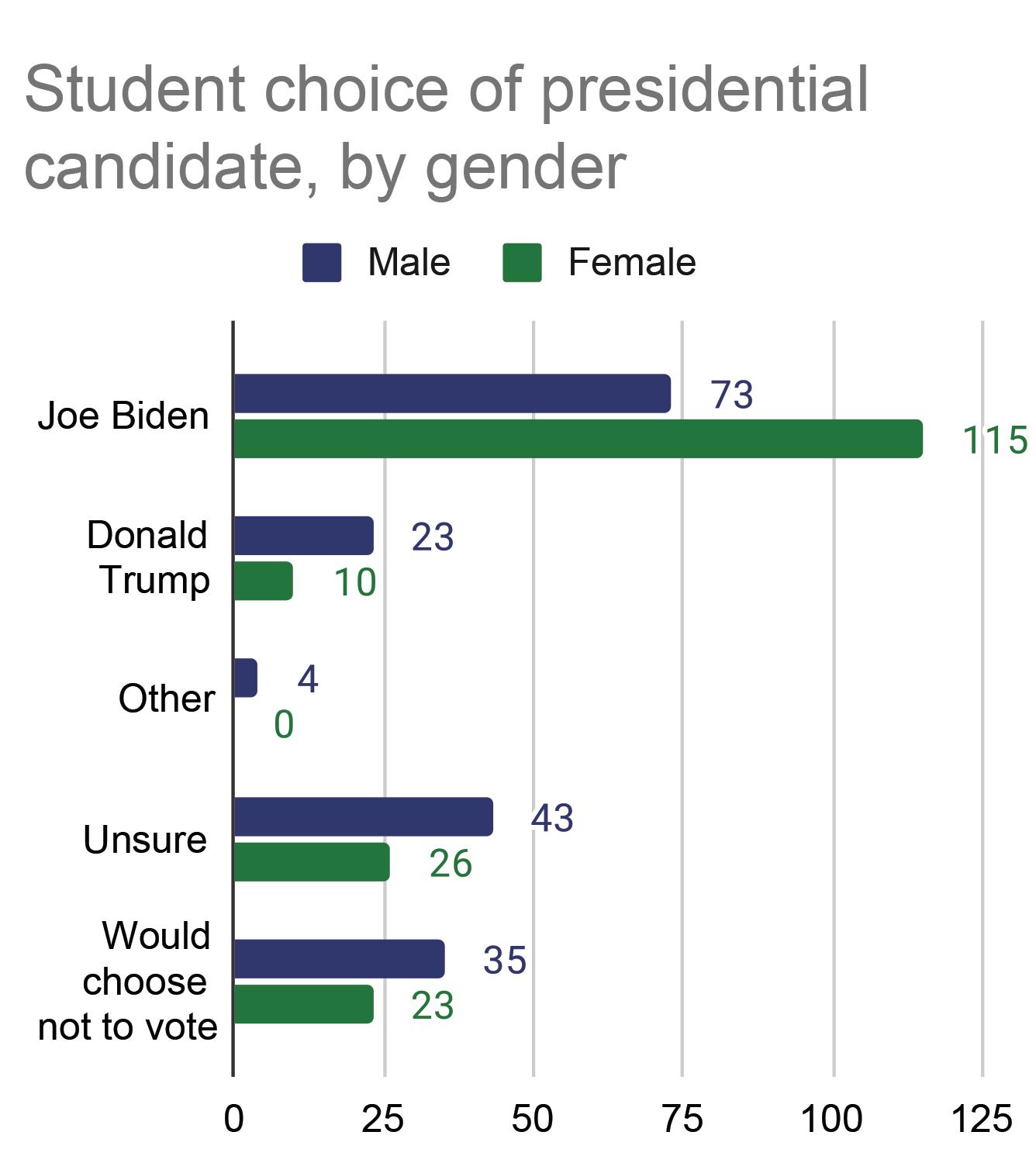
and Barbara Lee tied at 10 votes each, with Katie Porter a close second at 9 votes.
Males were more likely (18.3%) to report that they would not vote, compared to females (4.7%). By contrast, more females (88.8%) than males (68%) said they were unsure of who they would vote for.

When looking at the 2004 data for the media students used to follow campaigns, most of us didn’t know the difference between network and cable TV. But 20 years ago, both were the media of choice for survey respondents (68% for cable TV and 45% for network TV). Students could check more than one medium on the survey.
In 2024, those numbers decreased: 38.5% of students followed political campaigns through any type of TV network. And 12.3% of them listened to campaign news on the radio, compared to 20% in 2004.
The percentage of students who followed campaigns through print publications also decreased. In 2004, almost half of the students read newspapers and 24% read newsmagazines; in 2024, only 11% of respondents followed political campaigns through any type of print publication.
By far, digital media has overtaken these alternative forms. In 2004, 35% of respondents said they used the Internet (or “the Net,” per a Paly government teacher) to follow political campaigns. Now, 59.2% of students use online news publications and 62.3% use social media, which didn’t exist in 2004. Other sources mentioned by students included YouTube, podcasts and church.
Over 66% of current students said that friends and family members were a resource they used to follow political campaigns, which was the most-checked category. (Family and friends was not a listed category on the 2004 survey.)
Foreign policy issues are looming large in both the March 5 primary and the November general election.
One of the issues of interest is the Israel-Hamas conflict, the subject of a recent protest at Palo Alto City Hall. When asked to rate President Biden’s handling of the Israel-Hamas war on a 1 (strngly approve) to 5 (strongly disapprove) scale, the majority of respondents, 59.1%, rated themselves as in the middle (3). Just 9% said they strongly approved (1) while 30.1% said they strongly or moderately disapproved (4 or 5).
This is more favorable of Biden than national data as of Dec. 8, where, according to a Pew Research Center survey, 41% of U.S. adults disapprove of Biden’s response to the conflict.
Funding for Ukraine has also been a contentious national issue, especially within the Republican party. In the survey, 24.1% of respondents said they strongly supported Ukraine funding, 33.1% were moderately supportive, and 28% were in the middle.
These local student results are in line with national polling

on this issue, where 31% of the country believes too much aid is being given to Ukraine, according to a Dec. 8 poll from the Pew Research Center.
In addition, border security has been a politically volatile issue. We asked respondents to rate their opinion of President Biden’s handling of immigration on a 1 (strongly approve) to 5 (strongly disapprove) scale.
Significantly, this question was the least-answered one on the survey. We wondered if it was because students didn’t feel like they knew enough about the topic to answer, or didn’t have strong opinions. Of the 303 (out of 390) students who responded, 61.5% rated themselves as in the middle (3). Nationally, among those who disapprove of Biden, 19% of them blamed immigration as the biggest reason, according to a Gallup poll.
Although 89.8% of survey respondents were not yet eligible to vote, we still believe that learning students’ political opinions is valuable. In the near future, all students will have the chance to participate in the democratic process.
But learning about the views of the student body is not just important in a political sense; it also provides insight into who we are as a school. We’re tempted to wonder: What will have changed in 2044? v




I“T’S HARD TO HATE SOMEONE whose story you know.”
From Jan. 23 to Jan. 25, Breaking Down the Walls helped over 500 Palo Alto High School students learn those stories. This motto drove the program, which was run by educator Jason Jedamski of the Ignite2Unite organization, which aims to connect people on school campuses.
Around 30 years ago, Phil Boyte, the creator of the Breaking Down the Walls program, wanted to bring a community together after their school suffered a school shooting.
to Paly to lead 4A, a smaller program that focused on school spirit. According to Principal Brent Kline, the program left a significant positive effect on the student section culture during sports games. Because of this impact, Kline contacted Jedamski to lead another program for this school year.
“I felt it was important to open up this opportunity for more students than just 100 to be able to provide you all [Paly students] with opportunities to experience a community, to build community, and to share and learn other people’s stories outside the confines of your classroom,” Kline said.
“ Our goal is not so much to bring a lot of intensity emotionally to a program.”
— JASON JEDAMSKI, educator
Many students were initially doubtful about participating in BDTW. Skeptics compared it to another program, Challenge Day, that former Frank S. Greene Jr. Middle School students experienced.
To combat this notion, Kline and the Paly administration made sure to emphasize that Breaking Down the Walls would be different from Challenge Day by broadcasting this information on an InFocus broadcast on Jan. 16.
“It is absolutely not like Challenge Day,” Kline told the audience. “There are no tissues. There are no tears. We don’t want you to talk about your deepest fears.”
A large part of the day, however, included an activity called “Crossing the Line,” where students were lined up and asked to answer a set of questions and participants stepped forward if the prompt applied to them. The questions started less emotional: “Cross the line if you have your driver’s permit.” As the activity continued, the questions became more serious, with prompts such as “Cross the line if one of your parents has passed away.” Students were given the choice to respond to the prompt.
“They [the community] wanted to do something that would bring the students together,” Jedamski said. “The next year, another school wanted to do something similar.”
Last school year, Jedamski was invited
Junior and Greene Middle alumna Lillian Chen, who participated in Challenge Day in seventh grade, said that the program was too emotional for middle schoolers.
“The whole day felt inorganic because I felt forced to share my story and whatever I was going through at the time,” Chen said. “In the end, everyone was crying and it was an odd experience to have.”
This activity was also part of Challenge Day, where many emotional questions were asked.

Kline said he believes that the activity at BDTW was less emotionally taxing than the version at Challenge Day.
“I think it was more connected to your experiences at
school versus you as your own identity and your experiences individually,” Kline said about the difference between the two events.
Jedamski said the BDTW program questions are different from the questions posed at programs like Challenge Day because BDTW prioritizes sharing stories rather than sharing heavy emotions between students.
“Our goal is not so much to bring a lot of intensity emotionally to a program,” Jedamski said. “There might be a couple things we do that kids may have some feelings come up with, but that’s not our goal.”
Despite this, many students wanted to participate in BDTW. Junior Chloe Amos said she was curious about the program and wanted to experience the opportunity to meet new people.
“I just thought it’d be an interesting experience just to meet a lot of new people and have conversations that aren’t in an academic setting,” Amos said. “I heard people talking about how it would be similar to Challenge Day and how they didn’t like it [Challenge Day], but I was really curious.”
“ I thought it would just take a matter of hours and we’d have 1,000 students doing it.”
Kline said that his personal goal for student participation in the program was getting 1,000 students signed up in total for BDTW. However, he said that only about 500 students signed up.
— BRENT KLINE, principal
“I thought it would just take a matter of hours and we’d have 1,000 students doing it,” Kline said. “It wasn’t that way at all, but was the reverse and we almost had to convince students that this would be a good opportunity. And I just don’t think that Paly has done [enough] of these opportunities to know that it could also be a value added … for your educational experience.”
Senior Ella Bishop, a student leader at BDTW, said a reason why she signed up for the event was because of her experience with 4A last year.
“Already knowing him [Jedamski] and his organization coming back, I wanted to do it again,” Bishop said. “A lot of my friends had signed up for it, so that was a part of the motivation.”
While many students signed up voluntarily, others were required to participate as part of their classes. The Social Justice Pathway seniors participated as a cohort and non-seniors in the Social Justice Pathway were offered extra credit to sign up.
Additionally, Associated Student Body members were required to get at least 10
people to sign up as part of their grade, according to freshman and ASB member Paul Wang. Regardless of only getting 500 out of the anticipated 1,000 students to sign up, Kline said that the event was a success in his eyes.
“I think we nailed it on what you got out of it,” Kline said.
When Bishop participated in the program on Jan. 24, she said she felt as though some students were not participating in the activities, making her job as a student leader difficult.
“There were definitely other times where individuals weren’t as engaged, which was disappointing, but in a way a little expected whenever you have events like this,” Bishop said.
But sophomore Max Soparkar, who attended BDTW, said it was a positive experience.
“I think everybody should do it [BDTW],” Soparkar said. “It really brought the community together.”
Jedamski agrees with him on that.

“We just really want [students] to understand that they have a lot more in common than they do different with the people on their campus,” he said. v
Educator and head of Breaking Down the Walls Jason Jedamski gives a speech to a group of students. “It was very, very much a community building experience,” said sophomore Max Soparkar.

AS SOON AS THE LUNCH bell rings, hordes of Palo Alto High School students flock to the Embarcadero crosswalk between Paly and Town & Country. The moment the light changes, they spill across the street to get their lunch.
From an early morning drink from Peet’s Coffee to an after-school snack from Trader Joe’s, hundreds of Paly students shop and dine at Town & Country nearly every day. This upscale mall has undergone much change over the years. Remember Brandy Melville? Tin Pot Creamery? New stores have been moving in whilst others move out, changing the content of the mall.
In 2003, the Cold Stone Creamery at Town & Country was the franchise’s second busiest location in the U.S., according to owner Kathy Yang, yet that location has now been closed for almost nine years. Yang said that the proximity to Paly and Stanford University was a deciding factor in the franchise choosing to come to Town & Country.
“It [our customer base] was everyone, depending on the time of day,” Yang said. “During the day, we had a lot of families and young children, then after seven o’clock we had more adults and college students.”
According to Yang, the demographics of Town & Country customers have shifted.
“When I [the Cold Stone] was there, we had more senior citizens come to the
to more of an older audience,” Yang said.
According to owner Antoine Tang, Antoine’s Cookie Shop also receives a wide range of customers ranging from young children to older people.
“I’m really glad that I see people from all ages come into the store,” Tang said. “People bring their 3-year-
have Paly deals [and] they have saved me a lot of money with their discount.”
Jenny Bernabe, the manager of Tin Pot Creamery, an ice cream shop that closed in December 2022, said Paly students were a large part of the customer base in her shop and helped her predict the busyness of the shop each week.

 Art by JESLYN CHEN and DIVYA GANDHI
Art by JESLYN CHEN and DIVYA GANDHI

when they’re going to have a short day, so we could prepare beforehand.”
One of the many causes of closings are the strict rules and regulations enforced in Town & Country that stores need to comply with in order to have a successful business.
“If you’re closed any day, like December holidays, you’d be shocked,” Tang said. “There are $1,000 per day [fines].”
want to participate in this mall [Town & Country] … you have to be congruent with the rules,” Tang said. “We benefit from that too, from all the stores being open, because if other stores are open … that’s a good experience for the customer.”
The manager of the Blue Mer-
you will get fined if you open or close early,” Brice said. “That’s just a negative for me as someone that works here, but that’s more a positive for the shoppers.”
“ I’m really glad that I see people from all ages come into the store.”
— ANTOINE TANG, owner of Antoine’s Cookie Shop
pect of residing at this mall but can see how it helps the customer. “You’re not allowedside of your door and
Another major factor that affected the success of stores was the pandemic. Bernabe said that the pandemic was the biggest cause of Tin Pot Creamery shutting down, especially considering how many previous customers were students.
“The way the consumers are purchasing … [is] a lot more going into online business,” Bernabe said. “It [the pandemic] really impacted us when you guys [students] were totally out of school.”
According to Brice, both shop owners and the customers benefit from the community aspect of Town & Country, which creates a pleasant atmosphere.
“We’re surrounded by other wonderful retailers,” Brice said. “There’s also some delicious food like Telefèric and Wildseed and I really liked the clientele here … people are usually in a really, really happy mood and that just makes for a wonderful experience in store.”
Despite the many changes Town & Country has undergone, it remains a quintessential part of the Palo Alto community.
“Since my first year here, I’ve seen a lot of restaurants have come in and gone out,” Song said. “I think, no matter what, Town & Country will always be a staple for students.” v



IN NOVEMBER 2023, Congresswoman Anna Eshoo announced her retirement after serving large sections of the Peninsula for more than three decades. Eshoo’s decision not to seek reelection leaves an open congressional seat for California’s District 16, which encompasses the area between Pacifica and Los Gatos.
Primary elections in March will determine the top two contenders advancing to the November general election, regardless of party affiliation. This election comes at a critical time for California, with pressing issues such as housing affordability, healthcare access, environmental sustainability and economic recovery.
With 11 candidates running, the race
includes a diverse range of perspectives and approaches to these issues. Current frontrunners include Rishi Kumar, Sam Liccardo, Evan Low, Julie Lythcott-Haims and Joe Simitian according to ABC News and polls by RMG Research. Additional candidates include Joby Bernstein, Peter Dixon, Ahmed Mustafa, Peter Ohtaki, Greg Tanaka and Karl Ryan. A majority of the candidates are running for Congress as Democrats, with the exception of Peter Ohtaki and Karl Ryan, who registered as Republicans.
On Feb. 4, Verde used paper ballots to anonymously survey 390 Palo Alto High School students across 16 social studies classes.
The survey, which included students
Evan Low has represented District 26 in the California State Assembly since 2014. Prior to his job in the state assembly, Low served as a member of Campbell City Council. He was elected mayor in 2010, becoming the youngest openly LGBTQ mayor in the country at 26 years old.
“I ran for office when I was 20 years old because I did not feel that our city was advocating for the issues that young people cared about, includ ing economic justice, the environment and affordable housing,” Low said in an inter view with Verde on Jan 29.
Low, now 40, said that he remains pas sionate about these issues, especially af fordable housing.
“These [housing] issues dispropor tionately impact young people, whereas for previous generations, housing was much more affordable … [Now] there’s a 20-year high of interest rates and the cost of housing and rent is at a 45-year high,” Low said.
In addition to af fordable housing, Low said that he is
of each grade level, showed that Julie Lythcott-Haims received more votes than any other candidate, followed by Rishi Kumar, Joe Simitian, Evan Low and Sam Liccardo. Still, Lythcott-Haims received just 6% of total votes, as a majority of students in the poll were unsure of who to vote for or chose not to vote.
We have compiled short biographies of the candidates by visiting the congressional debate on Jan. 31 hosted at City Hall by Embarcadero Media, emailing Rishi Kumar and conducting interviews with Evan Low and Julie Lythcott-Haims.
Verde has also consulted the campaign websites of each candidate to learn more about their stances and proposals for legislation and issues. v
passionate about ensuring that young people are being represented in politics. In 2017, he authored the Vote 17 proposition, which would allow 17 -year-olds to vote in the primary and general elections.

Low also co-authored Proposition 1 in 2022, which advocated for the inclusion of abortion rights in California’s constitution, and Proposition ACA 5 in 2023, which would protect same-sex marriages within the California Constitution as a fundamental right.
“I am openly LGBT, and we have one of the most homophobic leaders in Congress as the speaker,” Low said. “And that’s why we need to make sure that we send more people who understand these life challenges about basic human dignity and the rights, because you can’t legislate LGBT people out of existence.”
In his campaign so far, Low has secured endorsements from the California Legislative LGBTQ Caucus and Ro Khanna, who represents District 17 in Con-
Julie Lythcott-Haims is a member of the Palo Alto City Council and former dean of Stanford University. As a Generation X parent and the only female candidate, Lythcott-Haims said she believes she can bridge the generational gap within the legislature and provide a first-hand perspective on a variety of issues.
“In this American era, our rights as women — our rights of bodily autonomy and reproductive freedom — have been really eroded by the Supreme Court,” Lythcott-Haims said in a Jan. 28 interview with Verde. “Now is not the time to be replacing a congresswoman with a congressman, at least not automatically. … I would never say my gender is the only reason to vote for me at all. However, I do want voters to be aware that there’s one of us out of the 11 who knows what it’s like to carry a child.”
This milk tea was creamy and sweet but lacked a strong hazelnut flavor. I added the Konjac Jelly that was featured in the picture on the menu for an extra 80 cents. Konjac is a root vegetable commonly used for its starchy bulb root. The jelly was delicious — its mellow flavor wasn’t as sugary as the brown sugar
cott-Haims is a best-selling author and public speak er. She said that these experiences have allowed her to connect with younger generations and understand the problems they are facing. In particular, she emphasized concerns about cli mate change.

Rishi Kumar has experience working in the technology industry and served two terms on the Saratoga City Council after being elected in 2014. Kumar ran against Eshoo in the 2022 congressional election and received 42.2% of the vote, making it the best performance by a challenger in three decades.
During his tenure on the City Council, Kumar helped organize protests against PG&E and helped reduce utility rates.
“As a council member, I challenged the system and the status quo, unafraid to be the dissenting vote on burning issues that went against the people,” Kumar wrote in an email to Verde on Feb. 14.
Kumar was concerned with the fact that in 2017, as customers con served water, the San Jose Water Company was raising rates and continually in creasing their profits, and spear head
“Climate change is an existential threat for your [the younger] generation,” Lythcott-Haims said. “And those of us who are older, have not gotten it [the threat of climate change] as clearly as we should have. This is about spending the money on renewable clean energy resources. It’s also about changing behavior — it’s getting a lot of people to appreciate that we need all hands on deck.”
Lythcott-Haims also advocates for reforming immigration systems at the Mexican border.
“I am tired of the republicans using immigration as a political football,” Lythcott-Haims said. “I am tired of them shipping human beings from the southern border on planes and buses to other cities. It is absolutely, utterly
Lythcott-Haims’s endorsements include Senator Cory Booker of New Jersey and Pennsylvania congresswoman Chrissy Houlahan.
ed an effort to remedy this issue.
“I led efforts to reject 10 [of] San Jose Water Company’s rate increases, easing the worries of a million ratepayers,” Kumar stated. “I pushed back against crazy rate increases by PG&E. I am the only candidate in this race who has pushed for the municipalization of both PG&E and San Jose Water Company as they are clearly not working in the interests of the ratepayers.”
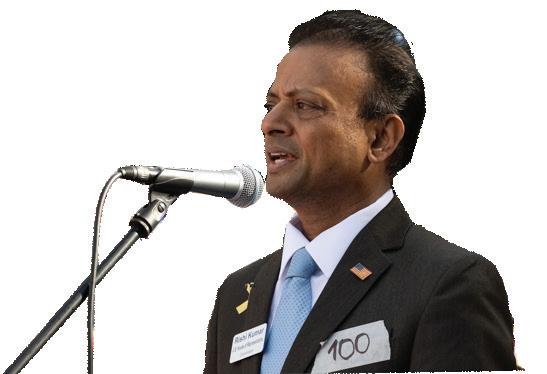
Kumar also works with a variety of non-
“I launched the no-charge Entrepreneurship Bootcamp for youth across Silicon Valley, training, educating and empowering thousands of disadvantaged students,” Kumar wrote. “We were able to implement this pathway to empowerment and learning through STEM in many low-income areas of San Jose. I have also hosted the no-charge Lego Robotics Bootcamp for many years to teach robotic design and programming.”
Kumar has been endorsed by Palo Alto councilmember Lydia Kou, Milpitas mayor Carmen Montano and Cupertino mayor Darcy Paul.
Joe Simitian has served as a Santa Clara County Supervisor for over 10 years, but has been involved in the Bay Area political scene since the 1990s. He served as a member of the Palo Alto City Council from 1992 to 1996, mayor of Palo Alto from 1994 to 1995, a state senator from 2004 to 2012, and served on the Palo Alto Unified School District board. Simitian is also a 1970 Paly graduate and served as Associated Student Body President when he was a student.
In a 1984 Campanile article, Simitian reflected on his tenure as student body president.
“I was really caught in the middle,” Simitian said. “I was the first student body president who was not a ‘4.0 varsity letterman,’ yet radical students thought I was not progressive enough.”
As a state senator, Simitian authored multiple bills, including one that passed in 2011 to have California acquire 33% of its energy from renewable resources by 2020. In the Jan. 31 debate, Simitian advocated for strengthening the electrical grid and maximizing battery capacity to store energy.
Simitian also created the County Med-Assist program, aiming to improve access to health resources, and contrib-
uted to the county’s Defender of Reproductive Freedom declaration, advocating for reproductive rights.
Simitian said he believes that his experience in state government will help him better anticipate the needs of voters at a more local level.
“It’s time for a fresh perspective,” Simitian said in a Jan. 31 debate. “I have that fresh perspective.”
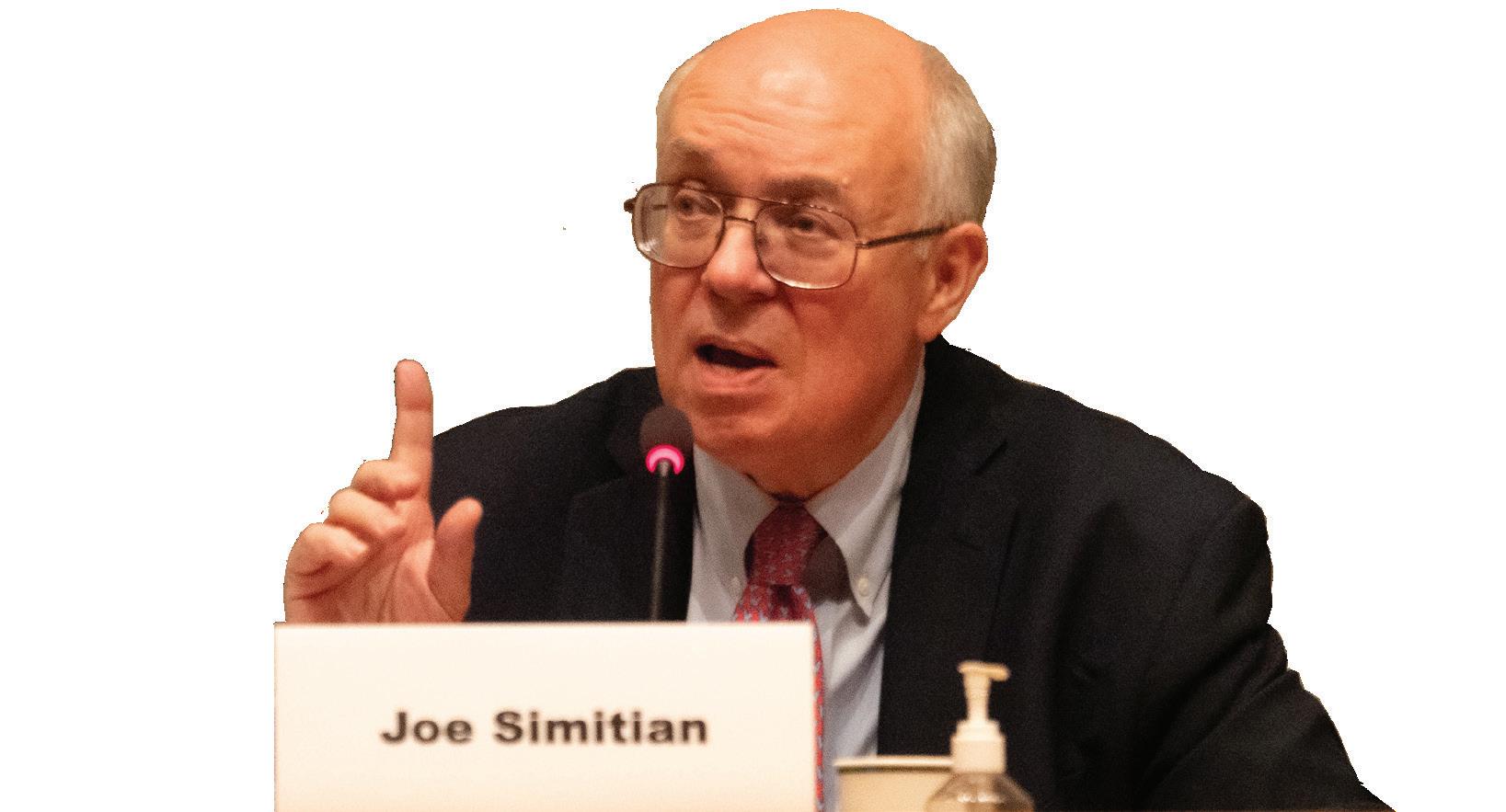
Sam Liccardo served as the mayor of San Jose from 2015 to 2023. During that time, he helped create the city’s first budget surplus in two decades and advocated for numerous pieces of legislation to protect wildlife and open spaces from development.
In the Jan. 31 debate, Liccardo said that he supports addressing climate change by reducing gas emissions in homes and new construction developments.
“We have to rapidly transition off of fossil fuels and the path to do so is to get on the grid, and we need a lot of investment in the grid to make it more resilient and reliable,” Liccardo said.
In addition to climate policies, Liccardo also shared his ideas about reforms for the capital gains tax system, which currently places a tax on profits from the sale of an asset held for more than 1 year.
“We need a fairer tax system. I don’t support the idea, however, of making long-term capital gains rates equivalent to short-term [rates], and I think there are many other ways to make this tax system fairer,” Liccardo said. “One of them might be … changing the threshold between short-
During the debate, Simitian also addressed one of the voters’ main concerns during the debate: his age. He is currently 71 years old and the oldest candidate in the race.
“I will not sit for 10 years, waiting to accumulate seniority,” Simitian said. “I will be ready on Day 1.”
Simitian’s extensive experience has earned him an endorsement from current congresswoman Anna Eshoo, as well as the Palo Alto Daily Post, which stated in a Feb. 9 editorial that “his [Simitian’s] priorities line up with those of the district.”
term and long-term from one year to, say, three years. So we’re truly incentivizing long-term investment over speculation and we’re rewarding the investment in this country we know will produce jobs and long-term growth.”
Liccardo also advocated for reforms within the current immigration system, including expanded border security.

“As a federal prosecutor, I used to prosecute criminal organizations that engaged in human trafficking,” Liccardo said. “We need more resources, we need technology, intel, border patrol agents. There’s no reason why we cannot have more border security at the same time we have a fairer immigration system with more immigrants.”
In his campaign so far, Liccardo has earned endorsements from former New York City mayor Michael Bloomberg, current San Jose mayor Matt Mahan and the San Francisco Chronicle.
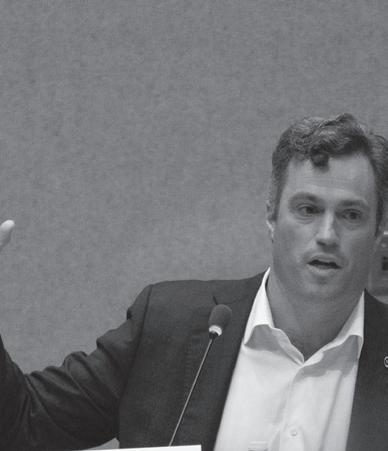
Joby Bernstein is currently pursuing his MBA at Stanford and has experience working as a policy researcher for the New Hampshire and Vermont state legislatures. He is a strong advocate for climate-focused policies.
“I’ve watched this state succumb to the most devastating effects of climate change, from wildfires to drought,” Joby said in the Jan. 31 debate. “I’ve watched an education system that has become out of reach for too many, from preschool to college. And I’ve seen some of the [my] smartest friends from abroad come here to study and yet get kicked out due to Visa problems. We’re losing what is most vital to us: our environment, our neighbors, and our childrens’ future.”

Peter Dixon served in the U.S. Marines and worked for the State Department under the Obama Administration. Dixon is also the co-founder of Second Front Systems, a cybersecurity company.
He used an artificial intelligence-assisted campaign advertisement and said in the Jan. 31 debate that while there are many positive aspects of AI and other innovation, he does hope to address the problems they may pose.
“It’s predicted that AI is gonna cause a loss of 20 to 40 percent of the jobs that we’re looking at as a society,” Dixon said. “We have to think about that and we have to figure out how to deal with that as a society.”
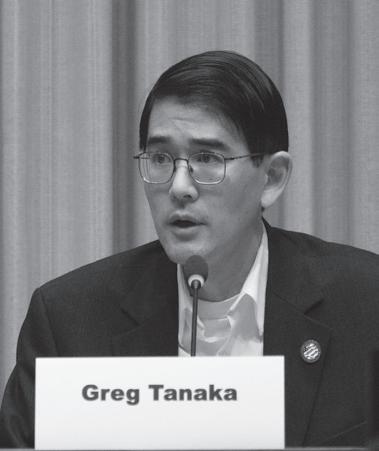
Greg Tanaka is a member of the Palo Alto City Council and a Paly parent. He ran for Congress in 2022, ending up with 6.6% of the vote and finishing sixth overall. Climate change is one of Tanaka’s priorities and he has expressed his concerns about prohibiting fossil fuels in homes and new construction.
“While I believe electrification is a great long term solution, we have to be practical about it,” Tanaka said in the Jan. 31 debate. “There’s economic concerns … but also, in some places like rural areas, natural gas is the only viable solution.”
Tanaka’s endorsements include former presidential candidate Andrew Yang and Palo Alto Vice Mayor Lydia Kou.

Peter Ohtaki served as a member and mayor of Menlo Park City Council. Ohtaki ran for Congress in 2022, finishing in third place with 12.6% of the vote.
As one of only two Republican candidates in the race, Ohtaki said he believes in the importance of bipartisan compromise.
“I think it’s important to reach out across the aisle because we’ve had 25 years plus of polarization in Congress, and therefore nothing gets done,” Ohtaki said.
Ohtaki said that if elected he would work with the Problem Solvers Caucus, a group within the House that includes Democrats and Republicans and aims to foster bipartisan cooperation.

Ahmed Mostafa worked at Google and was formerly a women’s rights attorney, working pro bono to help victims of sexual and domestic violence.
Mostafa is dedicated to protecting women’s rights in Congress, voting for a ceasefire in Gaza and passing gun reforms.
“The best thing for the United States and the best thing for all our allies is a ceasefire in Gaza,” Mostafa said in the Jan. 31 debate.
Mostafa also said that he is willing to foster bipartisan cooperation if elected to Congress
“We can’t stick to party politics, and stick to certain terminologies to pass things,” Mostafa said.

Little else is known about Karl Ryan other than he is one of two Republican candidates and resides in Los Gatos.
Ryan was the only candidate not to submit any of his qualifications to the ballot and did not attend the debate on Jan. 31. Ryan’s official campaign website is generated by an artificial intelligence website builder, Mixo.
In 2018, Ryan made a Facebook page asking voters to write in his name against Zoe Lofgren, the current representative for California’s 18th district. Ryan is listed on the ballot as a small business owner and currently hasn’t filed any paperwork proving campaign fundraising.
Photo courtesy of Karl Ryan.



 VINTAGE PENINSULA CREAMERY ADS — Many student drawn ads are found in old editions of The Campanile.
Photos: The Campanile, 1965 (TOP RIGHT, BOTTOM RIGHT), The Campanile, 1960 (BOTTOM LEFT), The Campanile, 1978 (TOP LEFT)
VINTAGE PENINSULA CREAMERY ADS — Many student drawn ads are found in old editions of The Campanile.
Photos: The Campanile, 1965 (TOP RIGHT, BOTTOM RIGHT), The Campanile, 1960 (BOTTOM LEFT), The Campanile, 1978 (TOP LEFT)

 Text by JESLYN CHEN and CATE GRANEY
Text by JESLYN CHEN and CATE GRANEY

WITH burgundy booths and retro radios bolted to the walls, the Peninsula Creamery, a classic 1950s diner sitting on the corner of Hamilton Avenue and Emerson Street, holds decades of
The Creamery serves as a time capsule of the Bay Area’s dairy farm-
According to California State Parks, the Bay Area was California’s first major dairy center. Because of this, creameries were extremely popular in this area, providing milk to Stanford University and San Francisco.
Before Silicon Valley became a tech capital, cows roamed pastures on what is now Stanford Shopping Center, according to the city of Palo Alto’s website.
John Santana Sr. and J.B. Howell opened the Creamery in 1923 with the promise of fresh milk and cheap food, according to Creamery’s website.
In 1932, John Santana Sr. bought the Creamery dairy plant, where the milk was processed, located at the time on Alma Street.
According to the Creamery’s website, the plant was the sole milk provider to Stanford University and operated over 60 trucks before closing in 1985 because of the decline of milkmen. This plot of land was
turned into the Peninsula Creamery Dairy Store and Grill which still stands today.
The Peninsula Creamery diner and Dairy Store and Grill were originally owned by the same family, but now only the Dairy store is family-owned. The Santanas sold the restaurant in 1987 to Rob Fischer, who is still the current owner.
Peninsula Creamery still carries traditions started by the original owners.
It has kept the same recipes for items such as its meatloaf and egg salad and still blends its milkshakes in metal cans in an old-fashioned soda fountain way.
ads in The Campanile, The Stanford Daily and Madrono that date back to the 1940s. Even after reaching a huge milestone of 100 years, the Palo Alto community still appreciates this charming restaurant.
Palo Alto High School sophomore Ria Mirchandani said she has been going to the Creamery her whole life.
“ It’s simple: you want to support local business ... [or] the y’ll no longer be here.”
— JAMES SANTANA, current Peninsula Creamery owner and grandson of founder
James Santana, the current owner of Peninsula Creamery and grandson of the founder, shares the secret to the longevity of his family’s business.
“We’ve been around for 100 years [because of our] good food [and] good prices,” Santana said.
Located on High Street and Channing Avenue, Peninsula Creamery Dairy Store and Grill is the quintessential American diner with its signature deli sandwiches, such as its “Nifty” with turkey, bacon, avocado and jack cheese on sourdough toast and its classic buttermilk pancakes.
The Creamery has been an essential part of the Palo Alto community with many
“I’ve been going there since I was a little kid,” Mirchandani said.
“I’d be really sad if it [Peninsula Creamery] somehow became a Starbucks or another big company.”
Mirchandani says that the 50s diner vibe of the Peninsula Creamery is one of the distinct things that makes it stand out.
“My favorite thing about it [Peninsula Creamery] is probably the ambiance,” Mirchandani said. “It feels like a good environment to spend time in versus other ice cream places that have good food but they don’t have that small-town charm or appeal.”
Santana said that Palo Alto residents should continue to support Peninsula Creamery and other family-owned businesses.
“It’s simple: you want to support local businesses,” Santana said. “If you don’t, they’ll no longer be here.” v

BACK TO THE FUTURE (BOTTOM) Patrons of the Creamery today enjoy their meals in the same red booths as they did 60 years ago. (Photo: Cate Graney)
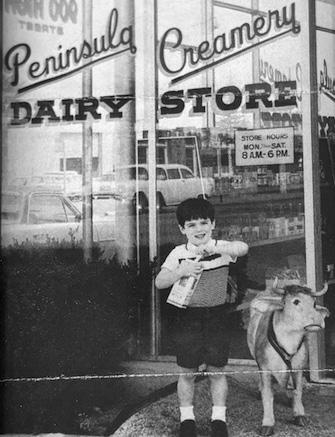





FACE-TO-FACE WITH AN intimidating stack of paper, Palo Alto High School freshman Kavita Fulton pulls out a pencil to start her geometry proofs. The past few days have been full of rigor as she prepares for her test. But, Fulton said she knows she’ll be ready. With pencil in hand, eraser to the side and a cup of chai on the table, Fulton digs in.
Fulton is one of many students who has benefited from the Palo Alto Unified School District’s 2019 decision to eliminate middle school math lanes, called Reimagining Math, which took effect during the 2020-2021 school year.
The change has led to an increased number of students in advanced math classes and better performance among the Paly graduating class of 2027, the first class of students since Reimagining Math was implemented.
According to former PAUSD School Board President and current Board Member Jennifer DiBrienza, the change has been successful in both encouraging students to challenge themselves in higher-level math courses as well as boosting their academic performance.
With the first 2023 fall quarter grades


being released, the school board was given baseline information as to whether taking away middle school math lanes has been successful.
“Across the board, kids were more successful in the classes they were in and more of them are in an advanced class,” Dibrienza said. “So on the whole our ninth-grade class is doing better than past ninth-grade classes. They’re in more advanced classes and they’re doing better in them.”
Before the change, PAUSD middle school students were given the choice to choose their math lane starting in the seventh grade. Students either selected the advanced lane, going on to take Algebra 1 in eighth grade, or the regular lane, taking Algebra 1 in ninth grade. However, after the change, all middle school students take Algebra 1 in eighth grade.
According to DiBrienza, the choice of a math lane difficulty level had long been a problem and was one of the main reasons the school board decided to eliminate math lanes, as a student’s math lane affected their self-esteem levels.
“Separating kids in seventh grade made some kids just think a certain way about themselves as a mathematician,” DiBrienza said. “If they weren’t in 7A or 8A [the advanced lane], they thought they weren’t good at math.”
Students not in the advanced math lane are also restricted from taking certain classes in other areas. To take Advanced Placement Physics C, students must be enrolled in at least AP Calculus AB. To take Physics H in junior year, students are strongly encouraged to be enrolled in at least Introduction to Analysis and Calculus. Students in the lower math lanes can only take these classes if they enroll in summer school.
Additionally, the question of equity
came into play when considering the demographic of students taking the lower middle school math lanes.
“The seventh and eighth lane [regular lane] was fine for some kids,” DiBrienza said. “But it was disproportionately filled with our historically underrepresented kids like our Black, Latinx, Pacific Islander, or low income [students].”
Along with the elimination of math lanes, the middle school math curriculum across all three grade levels was adjusted, making the jump to advanced math more feasible for students.
Daniel Nguyen, an AP Statistics and IAC teacher who has been teaching at Paly for eight years, said that he understands why the change was made, but feels it may harm students who do not learn at a quicker pace.
“Students learn at different paces and if we push students too fast, they might become discouraged, they might lose confidence that they’ve built up over time,” Nguyen said. “So it’s a very difficult situation but I know that the Reimagining Math program has caused a lot of kids to have to retake math.”
Geometry in ninth grade was not a surprising leap for her, as she felt adequately prepared for the algebra that is part of the geometry curriculum.
“I think they did a good job teaching algebra that we needed in high school,” Fulton said. “It was just right … We use some algebra in Geometry so the [middle school] curriculum was taught at a good pace in a way I understood.”
Additionally, Fulton felt middle school math lanes are not needed because students have resources to accelerate their math learning if needed.
“Some people did go to geometry in eighth grade, but only because they took a test,” Fulton said. “I think if you know you’re that at the level that you are [in math], then you’ll be fine in a harder class. It was good the way they had you take a test if you wanted to lane up.”
“Separating kids in seventh grade made some kids just think a certain way about themselves as a mathematician.”
— JENNIFER DIBRIENZA, Palo Alto School Board member
Despite the mixed feelings among students and teachers, DiBrienza said she believes that Reimagining Math has made a clear positive impact on students and wants to continue perfecting the new math curriculum.
A Paly freshman, who opted to repeat Algebra 1 and not have his name published in Verde, athat he would have preferred the option for a slower-paced math lane in middle school.
“It [middle school math] was too hard,” he said. “I think they should not have made the lanes higher.”
However, Fulton said transitioning from Algebra 1 in eighth grade to regular
“It doesn’t mean there’s not kinks to work out, or it’s perfect or anything,” Dibrienza said. “But so far, it seems to have made a real positive impact.” v
NEARLY 5.4 METRIC tons of carbon dioxide. This is the amount of carbon dioxide equivalent (MTCO2e) released by an average Palo Alto household per year since 2021, according to the City of Palo Alto’s sustainability and climate action plan.
Although five point four might seem high, compared to other neighboring cities, it is significantly lower by approximately 25 MT CO2e, according to Emeryville’s report on carbon dioxide gas consumption per household in 15 different Bay Area cities. This change in numbers is mainly due to Palo Alto’s community recognizing the urgency of fighting climate change.
One of the most recent steps Palo Alto has taken to fight climate change is implementing the Sustainability and Climate
certain points, we may have effects that compound on themselves and we can't reverse it,” said Brad Eggleston, director of Palo Alto city works.
Christine Luong, Palo Alto sustainability manager, agrees. Luong said worsening wildfires and rising sea levels could put Palo Alto homes in danger.
“All of the city infrastructure could be underwater,” Luong said. “These are real risks we have to address now, so we can prevent future possible disasters.”
[of percent of metric tons]. I think around six or seven digits. … It’s not terrible, but it's not where we want to be.”
“Right now, we're on track to be very close, but still miss it by single digits. I think around 6 or 7 digits … it’s not terrible, but it's not where we want to be.”
GREER STONE, Palo Alto City Mayor
Eggleston said to reach the “80 by 30” goal, the Palo Alto Sustainability Committee has formulated a list of smaller goals. These goals include reducing commute travel by car by 30%, reducing miles traveled overall by 12% and having all natural gas appliances replaced with electrical appliances in single-family homes.
“By 2030, we need 85% of all Palo

Because of this, Palo Alto is the No. 1 adopter per capita of electric vehicles in the country, according to Stone.
gets us to 80 by 30.”
Art by JESLYN CHENOther initiatives passed by the Council include the recently implemented Palo Alto Link program, which allows citizens with the Palo Alto Link app to get rides from a city-sponsored driver and electric vehicle to any destination in Palo Alto. Additionally, according to Stone, Palo Alto has strengthened its bike-friendliness by increasing the number of bike boulevards around the city. This benefits local students such as Julie Zeitlin, a senior at Castilleja School, who bikes to school every day.
Stone also said the majority of Palo Alto is powered by natural gas, which significantly contributes to greenhouse gas emissions.

“One thing the city has been doing is piloting a heat pump water heater program for residents,” Stone said. “We’re offering different financial incentives to be able to do that.”
“ By 2030, we need 85% of all Palo Alto new vehicle purchases to be electrical vehicles. [This is to achieve] a fleet overall that’s 44% electrical vehicles in Palo A
— BRAD EGGLESTON, Director of Palo Alto City
According to Zeitlin and Stone,
decision as the community to say, ‘Hey, I'm owning this. I'm doing something that's good for the community,’ ... I think that's something that we all kind of need to foster.”

Zeitlin is executive director and co-founder of the Palo Alto Student Cli mate Coalition, a student-directed board focused on educating local adolescents regarding the history of Palo Alto climate policies. Zeitlin said the PASCC focuses on providing students with the tools needed to advocate for climate action. An example of this is the public commentary they voice at the weekly City Council meetings.
“Almost every Monday, we come during the public comment section to give the council specific tangible policies and ideas that we recommend that they imple ment, to move faster to meet their main goal of 80% emissions reductions from 1990 levels by 2030,” Zeitlin said.
see, it seems like there aren't as many bikes
Stone said Generation Z and onward are the generations that will face the major consequences of climate change. Therefore, it is the younger generation’s responsibility to take action to face it.
“You [Generation Z] are the generation that's going to be impacted the most by [climate change], so I hope that through the natural human desire of self-preservation, people are going to make those right decisions,” Stone said. “Part of it too is go


Zeitlin said Palo Alto’s current climate initiatives are not enough.
“We will need to electrify nearly all single-family households and commercial HVAC [heating, ventilation and air condi tioning] systems,” Zeitlin said. “We're hop ing that by setting a date for which natural gas will be phased out of the city, we can create a more comprehensive timeline that



AS A VELVETY AROMA of chocolate wafts around the culinary classroom, students grow tense with anticipation. Student’s eyes are glued on chocolatier Carine Schultz’s every move as she gently taps the plastic mold against the counter. She then precisely lifts the top of the mold to reveal a beautiful array of shiny Belgian chocolate filled with raspberry ganache. Students’ eyes widen and the room fills with applause and bubbling conversation, exclaiming Schultz’s expertise.
As instructors of one of the five culinary classes at Palo Alto’s Adult School, Carine Schultz and her daughter, Palo Alto High School senior Reine Schultz, have provided the community with an immersive chocolate-making experience since 2021.
Each class is $60 per person and is hosted monthly from August to March in Room 103 at Paly. Walking into the classroom, students first see a stand in the middle of the room for Reine and Carine to perform their chocolate-making magic. Surrounding stations are meticulously prepared with ingredients for students to create their own ganache-filled Belgian chocolates.
Reine along for the journey from Australia to Hong Kong to the United States.
“It [chocolate making] was a thing my mom and I would always do together,” Reine said. “Especially [while] moving around, it was always a thing the two of us had in common.”
Reine said she started baking at a young age and began chocolate-making around 12 years ago. Now, Reine manages marketing and the Instagram account for the class. During class time, Reine constantly circles around the classroom, assisting students and working behind the scenes to set up for her mom to demonstrate each step, allowing the class to run smoothly.
“Reine has always been my little helper,” Carine said. “Every country we have been in, she has always been interested, always been on the side, always willing to help get full of chocolate.”
Carine and Reine both spend hours collaborating to prepare recipes, ingredients and lesson plans. Carine said she thinks it’s rewarding to see people succeed at chocolate-making, especially since chocolate is difficult to work with.
“Reine has always been my little helper.”CARINE SCHULTZ, instructor
The class, “Belgian Chocolates Galore,” begins with a step-bystep demonstration of the chocolate-making method the mother-daughter duo has mastered. Carine explains the scientific reasoning behind each step.
“You start with chocolate at room temperature, then you melt it down to 45 degrees Celsius,” Carine said.
As students receive a ladle full of luscious melted chocolate, they begin the meticulous process of molding and filling, allowing little room for error. Shannon Varty, an Adult School student, quickly discovered that she had begun a complex process.
“I don’t think anybody could just do that [chocolate making] on their own without instruction,” Varty said.
The class is the latest step in Carine’s 30-year-long global culinary journey, which was initially inspired by her family’s chocolate business in South Africa. Her passion became her profession as she pursued chocolate-making in European countries such as Belgium, Germany and England. She took

“When you de-mold their product and it comes out all shiny and it tastes so good, there’s nothing better than fresh chocolate,” Carine said. “It’s the reward of seeing people’s faces like, ‘Wow, I made that.’” v
SAY CHOCOLATE! (LEFT)— Reine and Carine proudly display their freshly made chocolate-dipped fruit and ganache-filled chocolates. The mother-daughter duo collaborates to prepare for lessons. “If I’m planning a class, I’ll always ask for her [Reine’s] input,” Carine said.
PERFECT POUR (TOP) — Students transfer chocolate from the bowl onto a marble slab to be tempered. “You want to create the stable crystal and by doing that you’re going to cool the chocolate on the marble slab,” Carine said.
INSIDE OUT (MIDDLE) — The mold is flipped to get rid of excess chocolate. “The chocolate is viscous,” Carine said. “It will stick to the shell of the mold creating the shape that you want to put your filling in.”
SCRAPING BY (BOTTOM) — Students struggle to temper the luscious melted chocolate with metal scrapers to reach the ideal temperature. “It [chocolate] is not the easiest thing to work with,” Carine said.
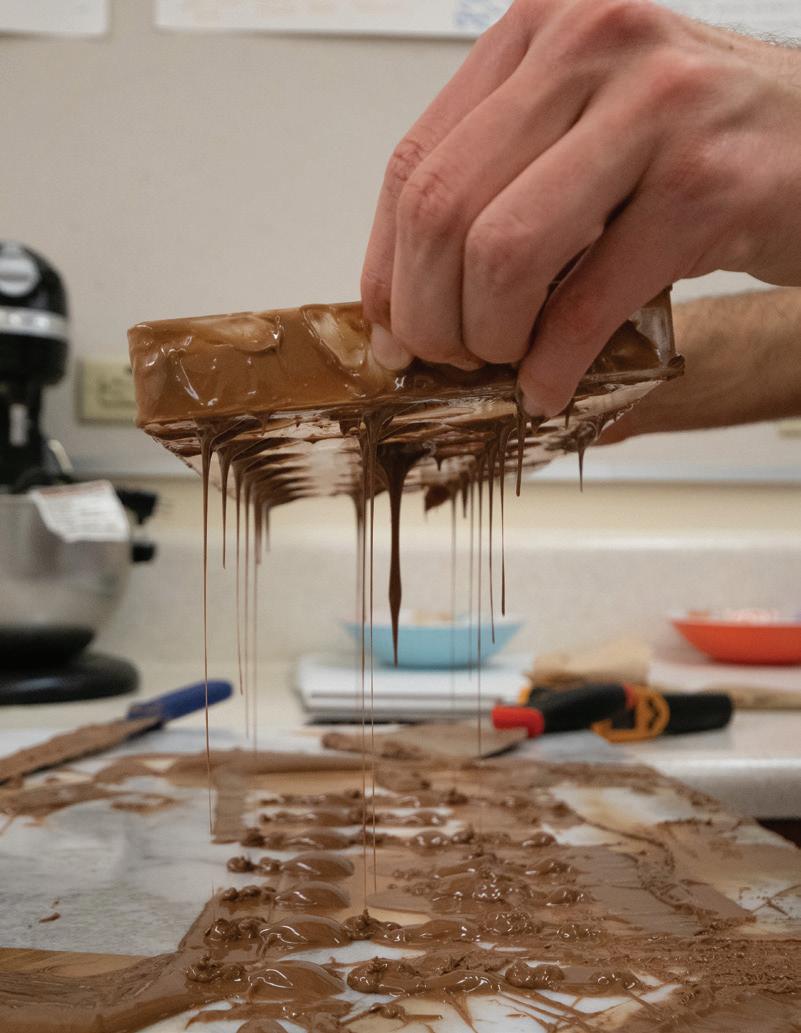

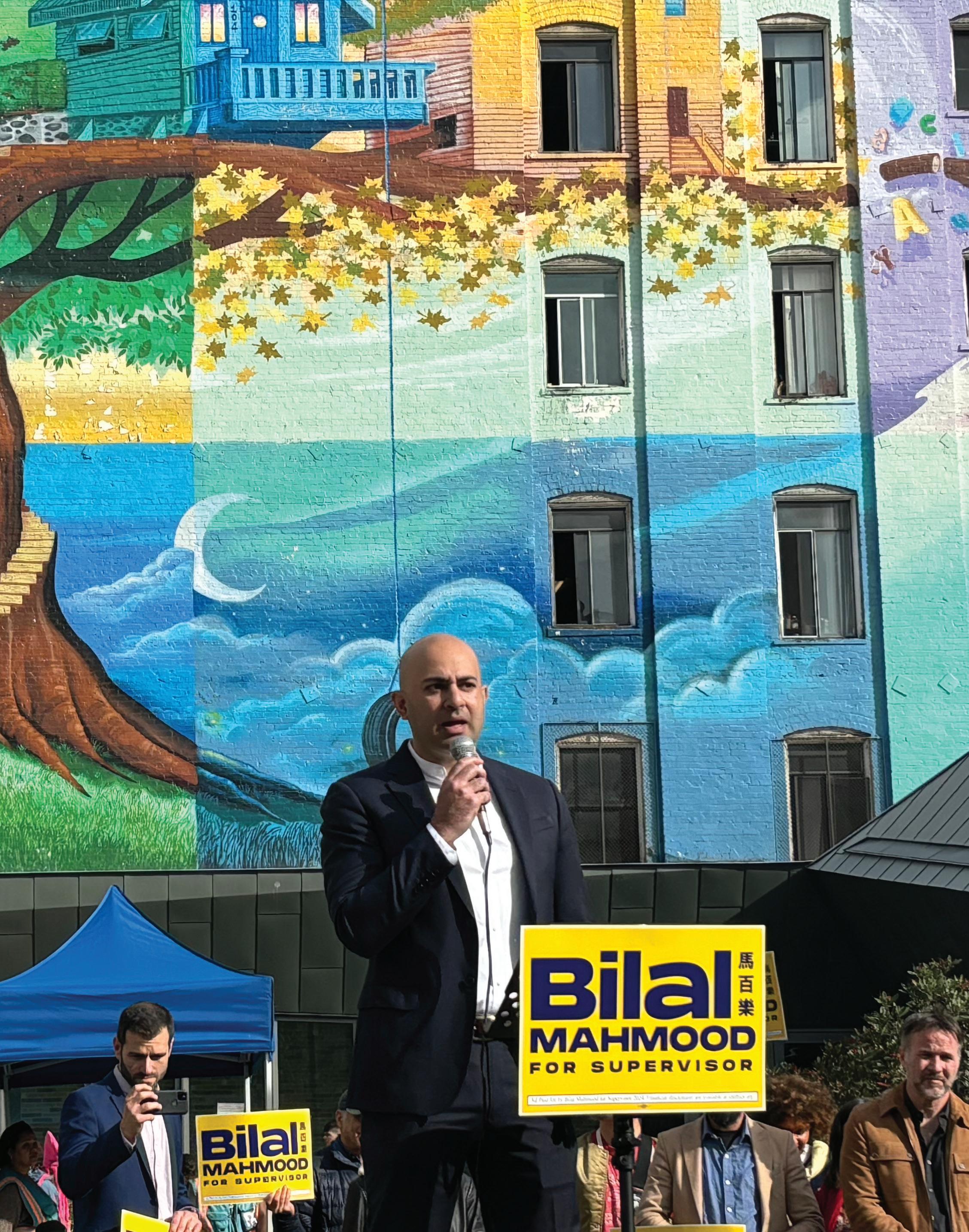

ON A SUNNY Saturday morning in Boeddeker Park, the heart of San Francisco’s Tenderloin, San Francisco Supervisor candidate Bilal Mahmood greets his diverse supporters at his campaign kickoff event. Behind Mahmood, a vibrant mural stretches across six stories.
A tree is painted in the center and branches connect many colorful houses to show both the unity in the Tenderloin and the housing problem it currently faces.
The words “Everyone deserves a home” dangles from a tree branch. As Mahmood prepares to speak, crowds hoist up his campaign signs.
Mahmood, a 2006 Palo Alto High School alum and former co-editor-in-chief for The Paly Voice, a Paly online news publication, is running against incumbent Dean Preston of District 5 for one of the 11 seats on the San Francisco Board of Supervisors.
gap in downtown San Francisco.
“A lot of small businesses are closing and we really need to revitalize our downtown-area economy,” Mahmood said. “We want to usher in more night markets for small businesses [and] want to bring in different types of economies here, like building universities downtown.”
After graduating from Paly, Mahmood received a degree in neuroscience from Stanford University and worked with the Obama administration as a policy analyst.
He credits Paly teachers like Esther Wojcicki — a former Campanile adviser — for instilling in him the resilience necessary to help fight for change within District 5.
“ I think that built into me a resilience — not being afraid of failure.”
BILAL MAHMOOD, City Supervisor candidate
“She [Wojcicki] would have us write an essay, but you could edit it as many times as you wanted,” Mahmood said. “I think that built into me a resilience — not being afraid of failure.”
With housing availability in San Francisco down from the prior year — at an alltime low, according to the San Francisco Standard — Mahmood proposes cutting down on permit requirements and other restrictions in place to make the process of building housing cheaper and faster.
“If we [the government of San Francisco] are able to streamline a lot of the bureaucracy that impedes building housing, we can build housing cheaper and make it more affordable,” Mahmood said.
Furthermore, Mahmood also hopes to address the city’s public health and public safety crisis, which is especially apparent in the Tenderloin.
“There’s an open-air drug market every evening,” Mahmood said. “[I’ll address] those issues through ending the bureaucracy and the corruption that is holding back a lot of government services.”
Lastly, Mahmood said he hopes to help small businesses to close the wealth
Through these lessons, Mahmood says he learned to come back stronger from defeat, such as his loss in the 2022 District 17 California 17th State Assembly election.
“This is my second time running for office,” Mahmood said. “We had about 100 people [at the last campaign rally] and now we have 300 people [at the new rally] here.”
Mahmood said he wished he knew that he could participate in politics as a high schooler and hopes current students will take advantage of these opportunities.
“If you show up to these [local government] meetings and make your voice heard … that’s a great way to get started and make an impact,” Mahmood said. v
SPEAKING TO SUPPORTERS — Bilal Mahmood addresses his supporters in Boedekker Park. “[District 5] gave my family a taste of home and I think right now, the community is struggling and it has been for several years and we need to turn it back,” Mahmood said. “I feel inspired to want to help because it [District 5] has been neglected for so long.”
TREE MUNOZ SHAPES THE CLAY with artful hands, smoothing the damp, beige-toned wedge as it spins on the pottery wheel in slow, even rotations.
“Steady your hand,” she says, turning to show the precise angle at which she has positioned the slab.
In Room 105, no two days are the same. In every class there, students pursue their artistic interests at their own pace, following their own creative processes, with Munoz — Palo Alto High School’s new Fiery Arts teacher — guiding them through every challenge.
“
“I’d like to leave it a better place than when I got there,” said Munoz, who uses she/they pronouns and is in their second semester at Paly.
Munoz said they see their role as an educator as more than just their career — they see it as their responsibility.
“Even though I was there [at Paly] to teach art, I was mostly … there to really care for my students,” Munoz said. “And I think that that’s my job.”
Many of their current students agree that so far, Munoz has been an exceptional teacher. Sophomore Orla Hedstrom, a student in Munoz’s third-period ceramics class, said she believes that Munoz’s support and encouragement of the craft allows students a chance to relax and unwind at a time when many are often worrying about their other classes.
“Everyone seems to be having a good time,” Hedstrom said. “I feel like it [the class] is a good break, like if you have a lot of challenging classes that day, it’s a great destresser.”
Since joining, Munoz has led events such as the Fiery Arts sale, helping students create pieces they can proudly display and sell outside the Performing Arts Center.
I teach art because I love it,”
— TREE MUNOZ, Palo Alto High School’s new ceramics teacher
Munoz teaches Art Spectrum, Advanced Placement 3-D Art and Design, Ceramics and Sculpture, and Advanced Sculpture at Paly under the Fiery Arts Booster Club — a Paly program that works extensively in glass and ceramics.
“I teach art because I love it,” Munoz said. “It’s the deepest kind of spiritual practice that I can imagine because I stand by and I sit by and I encourage when people are learning to make friends with their creative selves, trying things that they never imagined doing before.”
Munoz, who uses she/they pronouns, began their teaching career in 2011 as a substitute teacher. Since then, they have taught various art courses at other schools across California, such as Emeryville High School and Saratoga High School, working to elevate the minds and artistic pursuits of their students.
As an educator, Munoz hopes to support their students as best as they can and provide them with the necessary resources to become good artists.
On a personal level, Munoz strives to create an environment where all their students feel comfortable and accepted, drawing wisdom from their own experiences as a queer person growing up in the 70s.
“I knew I was queer in high school, and I went to a place where that wasn’t very popular,” Munoz said. “I felt like an outcast and a bit of … a loner, so I want it [their classes] to be a place of healing.”
“We start preparation three to four weeks, almost a month before the sale,” Hedstrom said. “You’re required to make at least 10 things for the sale … and then if your things get sold, you get half the profit you make from your own pieces.”
However, due to low enrollment and a lack of funding, the Fiery Arts Booster Club has been struggling.Sales alone have not been enough to support all the courses fostered by the program, which includes glassblowing — an optional activity that Munoz presides over, but hires professionals to teach. Instead, Munoz has had to resort to funding these from their own pocket, which has been both stressful and inconvenient for Munoz and her students.
“They [the classes] are amazing, but complicated, and I’d like things to be a little bit simpler,” Munoz said. “It would take a foundation grant or a donor to monetize an endowment so that the glass program is funded each year, and then it would be a question of hiring people to come in and teach and buy the materials instead of … how to fund [the class] as well as how to write it. So I love the program, but it adds a dimension of complication to my job.”
In addition to her contribution to the sale, Munoz’s care for their students is shown in the way they spend their time at lunch, opening doors to students regardless of whether they are in their class.
“My classroom is open at lunchtime, and you’re always invited to come in and sit there and play with clay,” Munoz said. “I do it because … I want everybody to have a place where they can feel welcome … and when you’re feeling awkward, it’s much better if there’s something to do, and ceramics is the easiest thing in the world.” v
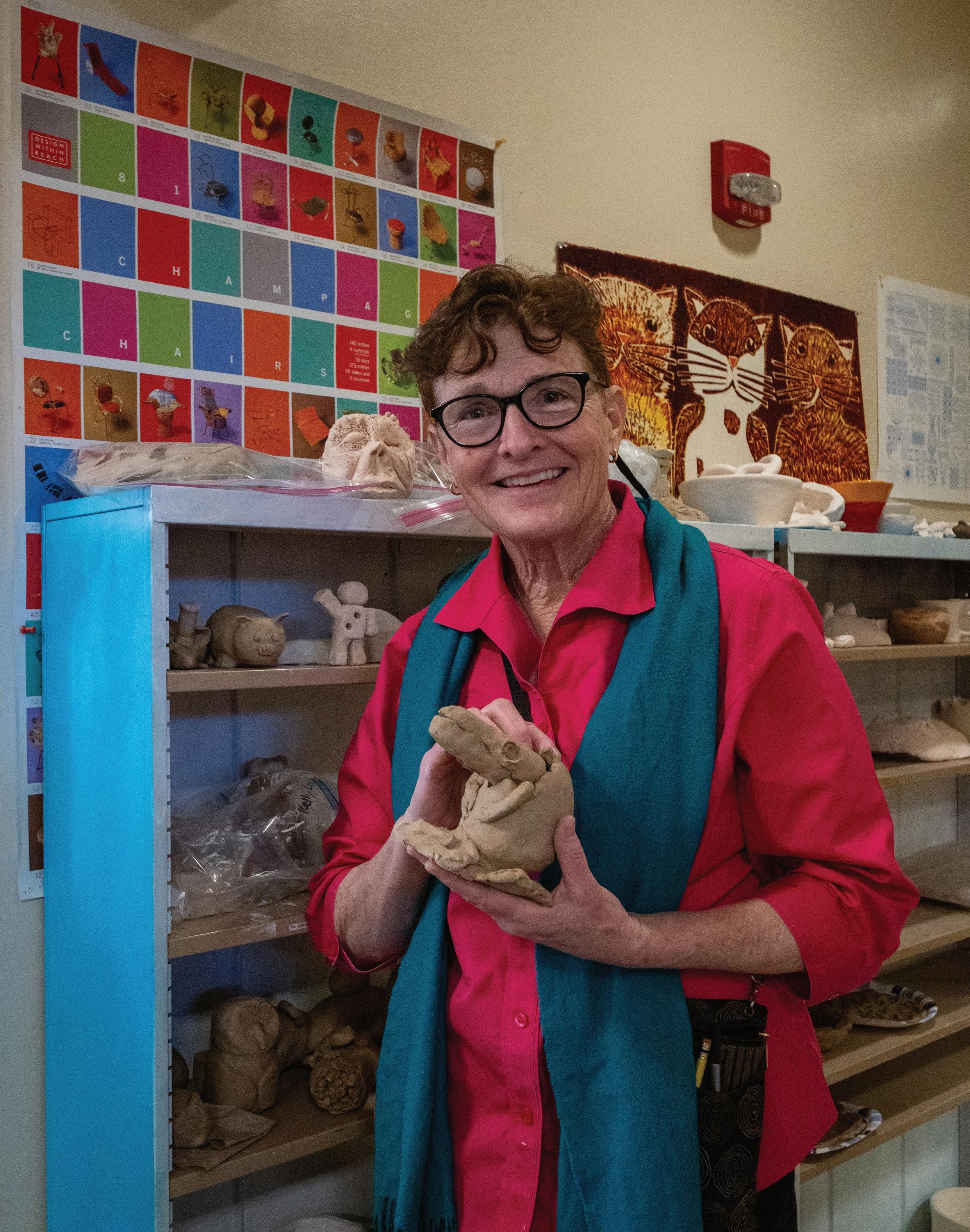 DYNAMIC CERAMICS — Tree Munoz, Paly’s new Fiery Arts teacher, holds one of many free-form clay sculptures made by her students. “People are unique,” Munoz said. “They all want something different, and in art, you get to do this.”
Photo by KENSIE PAO
Text by ANDREW KASSEL and LARA SASLOW
DYNAMIC CERAMICS — Tree Munoz, Paly’s new Fiery Arts teacher, holds one of many free-form clay sculptures made by her students. “People are unique,” Munoz said. “They all want something different, and in art, you get to do this.”
Photo by KENSIE PAO
Text by ANDREW KASSEL and LARA SASLOW
ONE BLOCK AWAY FROM Greene Middle School stands Cynthia Maina, wearing her bright yellow vest, holding up a bright red octagon, and stopping incoming traffic while waving along children on their bicycles.
“Don’t forget to do your homework!”
Maina said cheerfully to a group of middle schoolers passing by on their way home from school.
Maina is one of 32 crossing guards stationed each morning and afternoon at busy intersections near schools across Palo Alto to protect students from traffic. In a city where 60% of the middle and high school students walk or bike to school, according to local grassroots organization Walk Bike Palo Alto, Palo Alto also employs an unusually high amount of crossing guards, whose incredibly friendly attitudes brighten students’ days.
Although all the city’s crossing guards are hired through an outside company, they
are managed as part of the Palo Alto Police Department. According to Palo Alto Police Lieutenant Ben Becchetti, the program costs roughly $500,000 per year, which is included in the police budget, and employs more guards than programs in similar cities.
“A lot of cities of equal size have less [crossing guards],” Becchetti said. “So we’re very fortunate in Palo Alto that the community and the city council has placed an importance on them, which is awesome.”
According to Sylvia Star-Lack, a transportation planning manager with the City of Palo Alto, the city has one of the highest rates of walking and biking to school in the country, which is aided by crossing guards.
community, having grown up in the area with her siblings having gone to Paly.
“I could have left but I haven’t because I just enjoy it,” she said.
Beyond keeping students safe, Maina loves the familiarity she has gained with students while working as a crossing guard near Greene Middle School for the past four years.
“I would pretty much say we know each other, we wave, we say ‘hello,’” Maina said. “It’s, like I said again, familiar. It’s not awkward. It’s all about the safety of the community.”
“ It’s not just the fact that they [crossing guards] actually put their bodies on the line for our students, but they’re also often really a friendly face. ”
— SYLVIA STAR-LACK, Palo Alto Transportation Planning Manager
“It is rare for a city our size to have 900 to 1,000 students bike to each of the high schools … and part of that is because of these crossing guards that allow this kind of independent movement of students through town,” Star-Lack said.
Maina, who is posted at the intersection of Louis Road and North California, works a 45-minute shift at the beginning and end of every school day. She said she feels a strong connection to the Palo Alto
$500,000
Robert McDonnell, who is stationed as a crossing guard in front of Duveneck Elementary School, echoed a similar sentiment about his job.
“They [the students] mean a lot to me because I love kids,” McDonnell said. “And every time I’m not here yet: ‘Where’s Robert?’”
On the weekends, McDonnell can be found mountain biking in Half Moon Bay. Maina said she enjoys shopping for clothes and watching movies with her cats to unwind.
“I love scary movies,” Maina said. “I love comedies … because it is hectic out there. I like being by myself and spending
The estimated annual cost of the crossing guards program in Palo Alto
time with my cat.”
When they are on duty, crossing guards like McDonnell bring positive energy to their jobs, which has a huge impact on the students, according to Duveneck parent Jessica Galbraith.
“Looking forward to seeing Robert every day, you don’t realize the impact that he has … it’s like having a little puppy who’s excited to see you in the morning,” Galbraith said. “It brings so much joy and happiness.”
Star-Lack said she notices all the joy crossing guards bring to their jobs, which encourages more students to walk or bicycle to school.
“There’s a certain mood lift that you get when you exercise or walk or bike and it just feels better,” StarLack said. “When you have somebody fabulous like Robert who says hi to you in the morning, maybe gives you a high five and you’re 8 years old, it makes your commute.”
While students might only be around crossing guards for a few minutes each day, crossing guards can be valuable role models for young kids in a town that emphasizes alternative methods of transportation, inspiring the younger generation and encouraging them to make more conscious choices about their methods of transportation, according to Star-Lack.
“It’s not just the fact that they actually put their bodies on the line for our students, but they’re also often really a friendly face,” Star-Lack said. “Having adults in town that are friendly and responsible that kids can see is a really important kind of community builder.” v







WHEN WE FIRST walked walked into Oklava cafe, a new Turkish cafe tucked into a small storefront on University Avenue, we were immediately hit by the strong aroma of Turkish coffee. Past the glass panel storefront lies an almost overwhelming display case of hundreds of pieces of baklava, a traditional Middle Eastern dessert made of filo dough and pistachios, and sweetened with simple syrup.
Oklava, which translates to “rolling pin” in English, refers to the most important step of making baklava — ensuring that the filo dough is rolled as thin as possible. The display case is filled with baklava in over 20 flavors including pistachio, walnut, and hazelnut. Oklava also has a variety of different shapes and sizes. The small square bite is perfect for a quick snack, and the largest triangle shape is great to share with friends.
The cafe walls are decorated with black and white photos chronicling the history of baklava, along with pictures of Istanbul and historic Turkish figures. Though classical music does play, the cafe is not too loud. Oklava also offers free WiFi, which makes it accessible and a great place to study. It can be difficult to get a table since the cafe is normally crowded. ent lights.
Outside there is a finite amount of outdoor seating that faces Lytton Plaza — prime seating when the plaza has live performers.
The brightly lit shop shifts into a more intimate setting after sunset. Verde visited Oklava Cafe and tried an assortment of items ranging from drinks to pastries.
The Hot Chocolate ($5) is not overly sweet but lacks a distinct chocolate flavor. We found the flavor comparable to pow dered hot chocolate, but it could make a perfect pairing with one of Oklava’s many assorted pastries because of how it adds sweetness to the otherwise savory pastries. Turkish coffee is notoriously one of the strongest coffee varieties, and Oklava’s rendition ($6 pictured in the middle) is no exception. Served with sparkling water to
cleanse the palate and a small piece of Turkish delight to cut through the bitterness, this coffee lacks the unique bitter, intense aftertaste that many other Turkish coffees have, making it a stand-out item.
It is tradition when drinking this powerful coffee to first sip sparkling water to cleanse your palate. Then, take a small bite of the Turkish delight, a small cube made of starch and sugar, to give your mouth a sweet sugar coating and cut through the intense coffee taste.
Oklava’s main draw is its wide selection of baklava. As baklava lovers, we were excited to try a classic baklava ($3 pictured on the right), but unfortunately the sweet syrup had completely soaked through all the layers of filo, turning the traditionally light and flaky des sert into a sticky mess. There are better options in the area, like Meyhouse a few blocks down, or Baklava Story in San Francisco
Next, we decided to try something a little more untraditional. The server recommended the popular chocolate baklava ($4 pictuerd on the left). Sadly, the Chocolate baklava suffered from many of the same issues as the classic: the overpowering syrup masked both the chocolate and the pistachio flavors.
Pogaça ($4) is a traditional Turkish savory bread commonly filled with cheese, potatoes, or olives. We chose the classic, which isn’t filled, and found it to be thick and dense, perfect for dipping in hot chocolate. Although it wasn’t as complex as the baklava, we recommend trying it because it’s something new and unique that can’t be found at other cafes in the area.





Overall, Oklava has a comfortable and mellow atmosphere that is a good spot to get work done alone or to hang out with friends downtown. While we feel that the baklava and pastries could’ve been better, the Turkish coffee and other drinks are definitely worth stopping by for. Its prime location and late hours also make the cafe a perfect place to enjoy a warm drink and some live music across the street. v


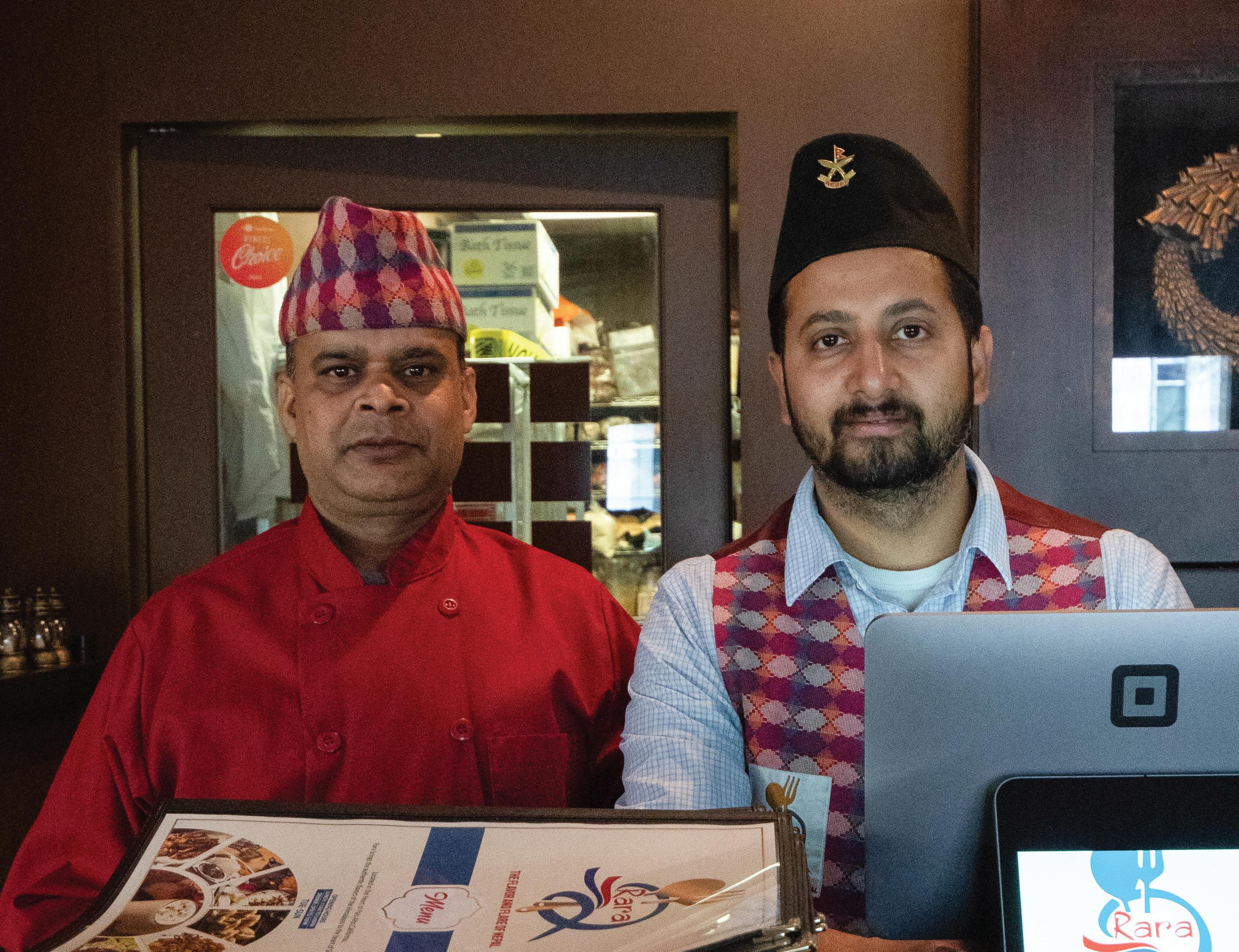
UPON ENTERING RARA, warm lighting, traditional decor and the aroma of delicious spices immediately transports customers to Nepal.
From the painting of the lake in Nepal from which the restaurant derives its name, to the soothing instrumental music, the ambiance is a perfect blend of authenticity and contemporary charm. As the sun begins to set, sounds of chattering diners fill the restaurant.
Rara, which opened in November, stands out among Palo Alto’s diverse dining options as the only Nepali restaurant. Situated at the end of California Avenue, the
restaurant offers authentic Nepali cuisine with a personal touch.
Head Chef Binod Poudel and manager Ishav Dawadi, are brothers-in-law.
“He [Poudel] is the head chef, and we are family,” Dawadi said. “We always wanted to open a Nepali restaurant.”
After high school in Nepal, Poudel got his diploma in culinary arts and started working in a restaurant as a sous chef in his early 30s. He has worked in five-star restaurants in Nepal, India, Europe and the U.S.
Dawadi started his career with a bachelor’s degree in hospitality management, and together, the pair wanted to combine their passions in a restaurant.
“We wanted to say ‘Hey, we are from Nepal, this is our food, this is our culture,’ and we wanted to bring that environment here,” Dawadi said. With a clear mission to showcase their Nepali roots, they also wanted to expand the locals’ palate.
“We wanted to see how we would do here in Palo Alto, because in Nepali [populated] areas, it would be too easy,” Dawadi said. “We want to introduce everyone to our food. Palo Alto is a very nice area because everyone here is respectful and open to trying new food.”
Rara doesn’t have dishes commonly found in an Indian restaurant on the menu, which may confuse customers who see similarities between the two types of food. Nepal, while close in location to India, has its own distinctive cuisine.
“So many of our customers when they came in they were saying ‘Do you have but-


ter chicken, do you have naan?’ and we had to explain to them that we don’t have it,” Dawadi said. “We explained to them alternatives like momos (top left), sizzlers (bottom right), 8848, chicken cauli, and they slowly tried it.”
For those who are unfamiliar with what to order, Poudel and Dawadi offer their recommendations. The most tried menu items are thenduk ($14.99-$16.88), momos ($14.99-$22.99), 8848 [a housemade sauce, bottom left], and Akbare [a spice grown in the Himalayas] chicken wings ($17.99).
Momos are steamed dumplings made fresh daily. They are usually filled with minced meat and served as appetizers, in soup, or pan-fried.
“We make everything here,” Dawadi said. “We make the dough and wrap them, and the spices are organic from Nepal.


The achar (sauce) is very unique because it comes with two kinds, one is a mint base, and one is tomato base.”
Thenduk is wheat flour dough cooked into a soup along with meat and vegetables. Other traditional Nepali dishes at Rara include kwati soup ($9.99), and choila ($16.99, top right ).
Starting a restaurant is never an easy process, however the pair said they are pleased with the results.
“We didn’t know how popular we would be in such a short amount of time,” Dawadi said. “We were thinking it was going to be a slow process. But word of mouth and everyone bringing their families and friends and leaving good reviews is really helpful.”
Dawadi and Poudel’s commitment to enhancing customer experience stands out through their warm hospitality.
“We don’t want the customer to just dine and leave,” Dawadi said. “We want to have them experience our culture, and make them feel like they’re at home. Everyone is so busy nowadays, they don’t have time to sit and eat. We want to make people feel like they are cared for. We might be from different places, but we want to make you feel comfortable and give our best.” v

YES DRAG AWAY FROM theater screen to viewers’ phones, as passionless CGI battles project overhead. Jokes are met not by the boisterous cackling of audiences, but by an agonizing silence. Somewhere in the room, a baby begins to cry. An excruciating sense of bore dom consumes the crowd.
latest film, “The Mar fran chise’s previous hits. The action isn’t
diminish considerably, both critically and commercially. So what’s changed?
Peter Canavese, a screenwriter and film reviewer for the Palo Alto Weekly, credits the success of the original movies with creating a loyal fanbase.
“They’ve had successes,” Canavese said. “In some ways, they [Marvel Studios] were in … a ‘can’t lose’ position because they had established all this goodwill.”
Now, they’re trying to go down a more artistic path.”
— KALI HENDERSHOT, President of Paly’s film club
Junior Kali Hendershot, president of Palo Alto High School’s film club, says she believes that the growing disinterest in the franchise is due to the change in marketing strategies, with the influx of new content overwhelming compared to previous years. Marvel’s biggest issue isn’t quality, but overexposure — a concept dubbed “superhero fatigue” by individuals who expect nothing less than engaging, good-quality blockbuster content.
an all-time series box office low of $199.7 million world wide, according to Variety.

ception in 2008’s “Iron Man”, popularity for Marvel Studios has boomed. So far, the franchise has accrued $29.8 billion at the box office, becoming the most commercially successful movie series of all time according to Movie Burner Entertainment.
However, the Infinity Saga’s end has seen the franchise’s success
“They [Marvel Studios] would … wait an entire year and build suspense, and then they would release one [movie],” Hendershot said. “It was just a great marketing campaign on their behalf. Now, there’s so much content being spewed out of Marvel I think it kind of muddies their whole brand.”
However, Hendershot says she believes that while many fans may not agree with the path Marvel Studios is pursuing, the movies themselves are still well-made and enjoyable.
“I don’t think that [the increased number of releases] detracts from the

quality,” Hendershot said. “Not everything is going to be a hit, but I think that there are some hidden gems in there that … deserve some more appreciation.
Canavese, on the other hand, questions whether Kevin Feige, the president of Marvel Studios, is ready to handle the mass production of films and series.
“I think that he [Feige] may have spread himself too thin,” Cavanese said. “He’s juggling with the TV side, and the movie side, and [there are] too many movies per year on top of all that.”
Since the Infinity Sa ga’s conclusion, Marvel has shifted attention from the global superstars that first drew audi ences — Cap tain America, Thor and Iron Man — opt ing instead to focus on smaller char acters with less name recognition, including ones from minority communities.
“

tier heroes, all the core original Avengers,” Canavese said. “They introduced a lot of interesting new characters, but I think without those marquee players … the audience started to slack a little bit.”
In addition, both Hendershot and Canavese believe that lack of vari ation is one factor con tributing to the films’ diminished popularity.
“I really commend them [Marvel Studios] for how risky they’ve gone,”
I think without those marquee players ... the audience started to slack.”
— PETER CANAVESE, screenwriter and film reviewer for the Palo Alto Weekly

While the likes of Shang Chi and Ms. Marvel have considerable popularity in their own right, their draw pales in comparison to previous, more notable characters.
Though Canavese respects the franchise’s introduction of new characters, he simultaneously wonders if the missing ingredient may just be established “star power.”
“The Infinity Saga starred all the top
peal to a general audience, because after Endgame, how many more epic brawls can you have?”
Canavese agrees, saying that it’s challenging for Marvel to explore new pathways when their entire brand is built off of one “formula” — a pattern already being observed with the 78% drop in ticket sales for “The Marvels”, according to Forbes.
“People are just getting tired of … [the] same old plot structure,” Canavese
said. “There’s going to be the hero, and the villain and the big showdown, and at least three big action sequences, and lots of CGI. And there’s only so many variations you can have on that formula.”
Although many have been surprised by the new approach Marvel has taken, Hendershot believes that we should embrace this new change.
“I just really like how they [Marvel] are expressing themselves in ways that are different from the original Avengers,” Hendershot said. “Now, they’re trying to go down a more artistic path.” v

AFTER A LONG DAY OF classes, extracurriculars and homework a late-night indulgence with friends is just what’s needed to regain a high schooler’s energy. When
the final assignment gets turned in and the sun has long set, what better way to treat yourself than with a cheesy slice of pizza or a freshly baked chocolate chip cookie? The Bay Area is home to many eateries that
keep their doors open late into the night and can satisfy the midnight cravings of the surrounding community. Verde reviewed a few of the best late-night restaurants in the area. v
A California staple located on the side of the US-101 highway, InN-Out closes at 1 a.m. on weekdays and 1:30 a.m. on Fridays and Saturdays. Known for providing cheap yet tasty American-style burgers and fries, the dining experience lives up to the restaurant’s reputation. We ordered the hamburger ($3.15), a small soft drink ($1.95) and Animal-Style fries ($4.25), a popular secret menu item. For its shockingly low price, the burger was satisfactory. The standout item was undoubtedly the Animal-Style fries. Smothered in melted cheese, grilled onions and the In-N-Out sauce, they make the perfect comfort food. The diner environment was also lively, despite the late night hours.The drive-thru option also adds to the restaurant’s appeal, earning In-N-Out a high overall rating.


Nestled on the edge of Stanford Shopping Mall, The Melt serves classic American-style cuisine, such as grilled cheese and shakes. It closes at 3 a.m. every day, the latest hours on our list. We ordered the Italian Job grilled cheese sandwich ($10.99) and Tomato Soup ($5.99), with a Mini Mac ($5.99) on the side, and were pleasantly surprised. The grilled cheese was crispy, with the melted cheese and mushroom combining in a harmony of textures. It was best dipped in the creamy tomato soup, which had just the right amount of umami flavor. The mac and cheese (Mini Mac), on the other hand, was subpar with its small portion size and cheese that cooled too quickly, with the macaroni sticking stiffly together. The Melt’s nonchalant environment cemented the 4.5/5 rating. The young crowd, combined with the dim lighting and pop music, locked in the casual atmosphere, making it perfect for late-night conversation.




Located in the heart of downtown Palo Alto, Pizza My Heart serves classic Califor nia-style slices until midnight every day of the week. The atmosphere was booming as customers filled all the red-leather booths, enjoying their slices and a soda on the side. Customers ate and chatted at the same time, creating a casual atmosphere for big parties of people. Football games lit up the TV screens, keeping diners entertained. We ordered a slice of the Big Sur and the Maverick pizza ($6.38 for each). The Maverick was a meat lover’s favorite topped with bacon, Canadian bacon, sausage, and pepperoni. The Big Sur has a more diverse variety of toppings: roasted garlic, tomato sauce, pepperoni, sausage, mushroom and green onions. The combination of the ingredients made the pizza enjoyable and comforting. Both pizzas had a thin crust and the perfect amount of crispness, making for an enjoyable late-night meal.

Since it opened in the spring of 2023, MJ Sushi’s simple, unlit red and white sign has beckoned to passersby on El Camino Real. The late-night closing times of 10:30 p.m. on weekdays, and midnight on weekends and Fridays, as well as the proximity to the Palo Alto High School campus, make this the perfect spot for post-football game dinners. Even after we arrived at 10 p.m., the crowd of about 20 people chatting and eating created a casual and enjoyable ambiance. Out of over 20 different House Special Roll options, we ordered the MJ Sushi Roll ($13.99), along with a side of gyoza ($5.99). The roll contains eel, tempura, cucumber and mango, wrapped in sushi rice topped with sliced raw salmon, house special sauce and fried tempura crumbles. For $14, the roll only came with six pieces — too few given the cost and the quality. The gyoza had a savory, well-seasoned pork filling with a hint of spice, although it lacked crispiness. The complementary savory sauce added an extra layer of flavor and for its low price of $6, we would order it again.

IT’S FEBRUARY, AND THAT MEANS THAT another round of course selections has come and gone. Students scramble to find a balance between classes that show rigor and ones that they anticipate succeeding in. But for many, it means finding the maximum amount of Advanced Placement and honors courses that they can physically handle in order to boost their GPAs and appeal to colleges.
Although Palo Alto High School’s administration recommends that students take a maximum of two AP courses per year, it’s common to see students taking well over that amount, often taking four or more, regardless of their interest in them. The competitive effect this has on the student body and campus culture perpetuates a harmful narrative about how we define student success in such a competitive environment. It comes down to this: why are so many students taking classes that they claim to hate and sticking with them for years?
importantly, it allows me to feel that the effort that I put into my school work will truly benefit me in the future.
Rethinking my course decisions was so hard for me because it meant a farewell from more advanced STEM courses, which I had come to see as the No. 1 indicator of my value as a student. The emphasis that the Palo Alto Unified School District and the students and parents it serves place on excellence in math and science is immense, and it shows in the way students and parents respond to their policies: No wonder the district has been sued twice in the past three years over their math placement policies.
In my junior year, I chose to leave the Honors science lane and take the standard Physics course because I was seeking out classes that aligned more with my interests and future goals, like AP English Language and Composition and AP U.S. History. It was a hard choice, not because I was particularly interested in taking Physics H, but because I felt that my value as a student had diminished. Going into the school year, I was skeptical of the change, but soon I found that I felt so much freer in that I was finally able to prioritize my workload based on what was meaningful to me.
Letting go of advanced science coursework has also allowed me to better under stand who I am as a student and what truly intrigues me. I encourage other students to consider en joyment when making their course selections rather than only what looks good on paper.
Lightening my load in some areas in order to focus elsewhere has made a diffi cult year more bearable, and most
As former Kentucky governor Matt Bevin so aptly stated in 2016, “All the people in the world that want to study French literature can do so, they are just not going to be subsidized by the taxpayer.” But are humanities and liberal arts students really all that unemployable? According to the New York Times, skills that come with a liberal arts education, like writing and problem-solving, are incredibly useful when it comes to the job search.
As I see it, this assessment of how different fields are useful to society is narrow-minded. Effective communication — a key tenet of humanities education — is a skill that can be applied to anyone’s life, regardless of their intended major or career path. Any workforce needs people to write their proposals, their marketing materials and their annual reports. Be it banking,
ment to consider the benefits that may arise when a student steps away from classes they don’t enjoy as much and into ones that they do, even if that means stepping away from an honors or AP class and into a lower one. After all, what value does academic excellence have without an understanding of the things we enjoy when we step off of ation stage and into the real




Pedicures, Manicures, Facials, Threading, Waxing, Eyelash Extensions and more!
650-948-4501



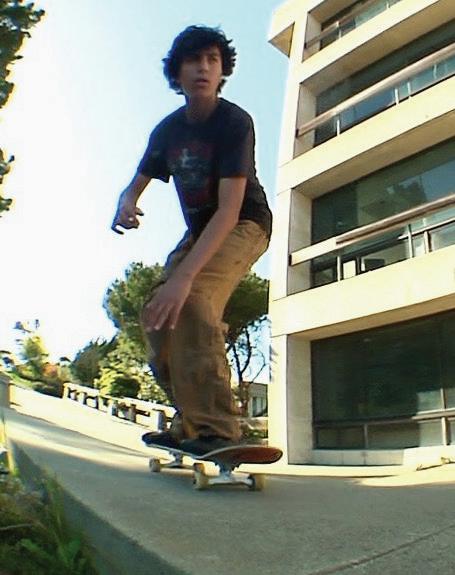



This is a question I’ve often faced over the years and each time I find myself unsure of how to respond. I have skateboarded for around six years and consider it to be a hobby rather than a sport, despite its recent addition to the Olympics.
I don’t view skateboarding as a competition against others, but rather as a competition against yourself. For me, how far you can push your limits and how much fun you can have are the most important parts.
Why start skateboarding? Besides learning a new and impressive hobby, skateboarding can teach valuable life skills like perseverance and confidence and also create a feeling of accomplishment and joy.
These all stem from the uncomfortable situations we skateboarders put ourselves in. The first time I ever went to the skatepark I was set on dropping in on a ramp for the first time, but was scared out of my mind. Dropping in is when you place the tail of your board on the edge of the ramp and slam down your front foot, rolling yourself down the ramp.
I ended up standing on top of that ramp for nearly an hour, wimping out every time I was about to go for the drop-in. I could feel sweat dripping on my hands, and an uneasy feeling in my stomach.
Finally, I became fed up with myself. I told myself that no matter what, I was going to walk to the edge of the ramp and go for it. With an immense amount of fear still in me, I put my board down on the top of the ramp and slammed my front foot down, fully committing to the trick.
A second later I was on the ground, my arm throbbing in pain, but I didn’t
care because I had JUST COMMITTED! Overcoming fear like this is a feeling like no other.
Half of you will be set on fully going for a trick, while the other half of you will be screaming at yourself, out of instinct, to stop and take yourself out of the way of danger.
Not listening to your body and overcoming something that you felt was impossible can be one of the most rewarding and joyous feelings.
Though this feeling is great, at the end of the day you won’t go home feeling accomplished if you don’t actually land the trick.
situations and feelings that you have not experienced before.
A more digestible benefit of skateboarding is the human connections you make along the way. I have met most of my closest friends through skateboarding, many of whom go to different schools, meaning I would have never met them in any other circumstances. All the great memories and connections I have made with them are thanks to skateboarding.
I ended up standing on top of that ramp for nearly an hour, wimping out every time I was about to go for the drop-in.
Right after falling, I ran back up the ramp and continued trying the drop-in, over and over again, constantly falling and getting back up, until I rolled away from the ramp.
Landing the trick is even more rewarding than the feeling of committing, and the perseverance that I have learned from struggling with tricks often helps me push through tough situations that I face in my daily life, from persevering through a hard math or physics problem to pushing through the pressures of high school.
You might be thinking “This guy is exaggerating,” or “This guy’s overhyping skateboarding,” and I get it.
To someone who has never skateboarded before, what I am saying can sound like a reach, or just not convincing enough to start skateboarding, as it’s hard to grasp
Skateboarding is something that you can bond over with any fellow skateboarder, whether it be by talking about tricks to sharing clips and spots, and is a hobby you can always turn to when looking for some fun.
Skateboarders can be some of the friendliest and welcoming people out there, despite all the negative stereotypes that people like to perpetuate about them.
People often label all skateboarders as stoners, or just bums, which is just not true and can often deter newcomers from starting.
I promise you that not all skateboarders are like this and you don’t have to change anything about yourself to start skateboarding. After reading this, I hope you at least try skateboarding and figure out if it’s for you. I will admit it’s not for everyone, but if you’re willing to get a little hurt and put in some hard work, you might end up finding a new fun hobby that could make you grow in ways you never expected. v
IF YOU WATCHED PHINEAS and Ferb as a kid, you know that in the show, Phineas and Ferb spend every day of summer building something new or pulling a new prank together. In every episode, their older sister (who is supposed to be babysitting) tries to get them in trouble, but Phineas and Ferb manage to clean up whatever they are doing just before their parents get home. Phineas and Ferb never get caught, but cut it closer and closer every episode. Their older sister always tries new tactics to try and get them under control but never manages to.
Ideally, after 104 days of summer vacation the babysitter has a handle on the kids, but sometimes it takes some time to find out what tactics work.
Picture two 6-and-9-year-old boys, “Sam” and “James”, respectivley. I had babysat them before, though it had been a while. Last summer, when I was with them they did not have the same kinds of rebellious ideas that they had this time. I would not go so far as to say they turned into Phineas and Ferb, but they had to have been somewhat inspired by them.
I got to their house around 5:30 p.m. and pretty quickly, we fell back into our usual routine: We played with Legos, ate dinner and then played some more.
After dinner, the boys decided that
they wanted dessert. James climbed atop the counter without hesitation to grab a huge bag of assorted candies, and both James and Sam had a few pieces.
As they continued to eat more I asked, “Is your mom OK with you eating this candy?”
Before Sam could get a word out James interjected, “Yes, of course, our mom always lets us eat candy after dinner.”
After another 10 minutes, a whole pile of discarded candy wrappers was sitting on the countertop, so I suggested we put the candy away and play a game.
“No,” James responded. “My mom said I could have as much as I wanted.”
game they wanted to play was “Let’s find all the candy in the house and run away from the babysitter.”
James pulled a bag of Skittles out of the cupboard under the sink, opposite where I was, and started to eat them. When I took those away, he grabbed a bag of HiChews from a different cupboard and ran away with them.
I found Sam and James huddled over the bag of Hi-Chews in the laundry room like squirrels with a pile of nuts.
Quite worried that this was a lie, I turned to Sam who shyly admitted, “Well, she never said we couldn’t…”
Using my best judgment, I decided to take the candy and put it back in the cabinet. I then stood in front of the cabinet in case James would try to make a break for it while we decided which game to play. To my disappointment, it appeared the only
This kind of disobedience is called testing boundaries, defined by Young Minds Network as “resisting instruction or rules given by parents and other authority figures.” The idea is that the kids will test the boundaries of what they can get away with and when the consequence becomes harsher than the reward, a boundary has been established for the child.
As a babysitter who had not seen these kids in a while and was not clear on any previously established boundaries, this was the perfect opportunity for the kids to test boundaries with me and see if they could push me further than they pushed their parents.
Playing these games was not really my
kind of fun. For them, on the other hand, it was like they were on the playground.
After a quick game of forced “hide and seek,” I found Sam and James huddled over the bag of Hi-Chews in the laundry room like squirrels with a pile of nuts. The second they noticed that I had found them, James popped up and ran to the kitchen.
“She’s not guarding the kitchen anymore, Sam. Come on!” he said.
It was like a two vs. one game of capture the flag in completely unknown territory.
I was clearly losing.
With the bag of assorted candy clutched under his arm, James screamed, “There are two of us and one of you! Hehe!” finally realizing his advantage over me.
I tried to keep my cool and my control over the situation. It would be so unnecessary to escalate an argument about dessert with a kid, I told myself.
After a long and brutal losing streak in which I watched Sam and James run around the house making me play Monkey in the Middle, I managed to get Sam to help me because he felt bad for me. Eventually I had all three bags of candy behind me. Expecting James to then accept that it was time to go back to playing games, I was in shock when I heard the 9-year-old scream, “Ugh, you’re such an a**hole.”
That was boundary test No. 2 for the night. Swearing at the babysitter is not something I’d consider within household rules. Trying to guess the parents’ boundaries had not worked so well for me earlier that night, so I just stood there, frozen. Deciding to ignore James’s inappropriate comment, we moved on to playing with some magnet tiles.
When the parents got home at the end of the night, I asked what their policy was with dessert. They didn’t have one. I could have sat there and let the kids eat candy all night until their little cheeks exploded.
I was in disbelief. All that misery over nothing. If I had known the boundaries, I would not have had to bother telling
these kids what to do all night. It makes me wonder whether Phineas and Ferbs’ parents would have cared about all their shenanigans.
All in all, I have nothing against that family and respect the boundaries they choose to set, but I learned a few lessons: (1) do not be afraid to ask the parents any questions about their house rules before they leave; (2) boundaries need to be set both with parents and babysitters they, are there for a reason; (3) I did not need to babysit for that family again until the kids grew out of their Phineas and Ferb phase. v


